The fascinating aspect in the development of the USN amphibious force in WW2 was its sudden and massive rise, with a steep progression curve in years. It started with improvuizations in early 1942 and ended in late 1945 as a finely-tuned machine. For the occasion of this 77th anniversary of the landings of June, 6, 1944, here is a two-posts release: On the 6th, an overview of all USN landing ships and landing crafts, support ships and variants, as well as amphibious vehicles of WW2. All used either by the USMC and US Army from the first operations in August 1942 to March 1945 and the preparation for Olympic. The second, on June 8, would be about the operations themselves.
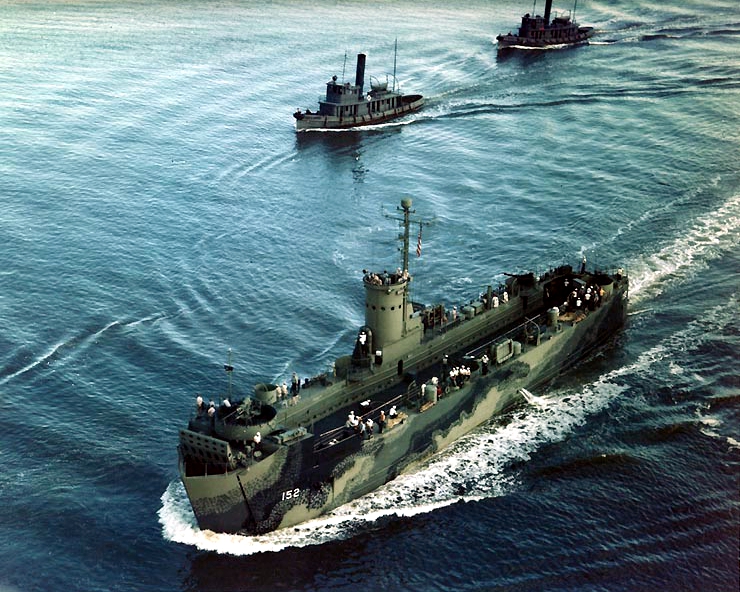
USS LSM-152 underway off Charleston NyD in 1944
This very long post is split between landing ships on the first part, and landing crafts on the second, then support ships and amphibious vehicles at the end (plus the usual resources, links, documents, books, models kits, videos and more).
US Navy Assault Ships
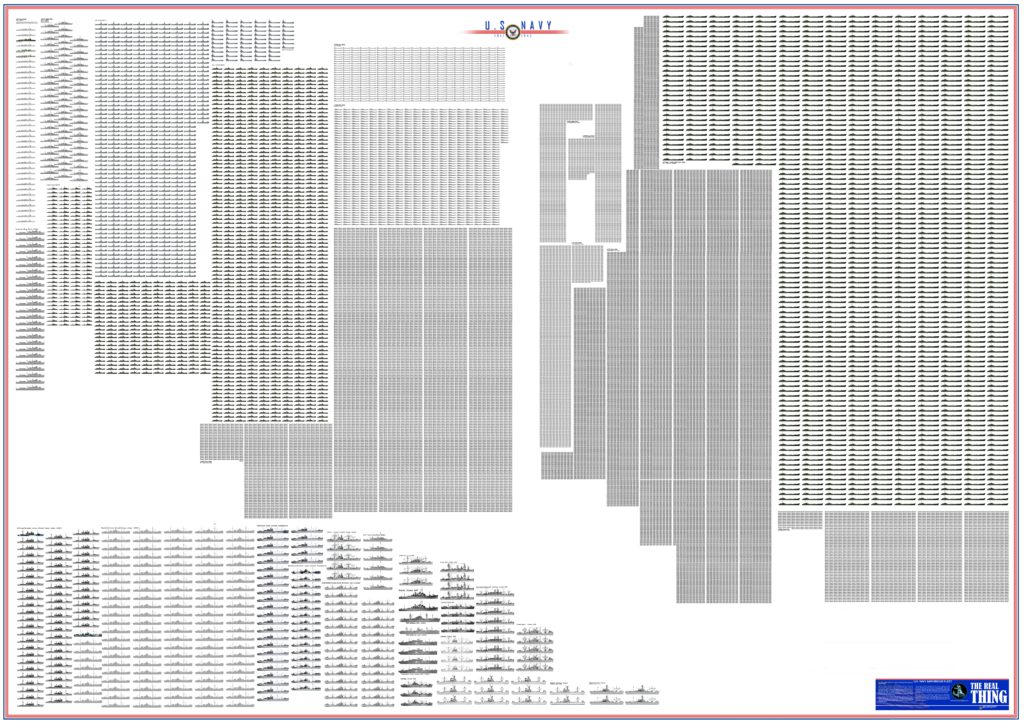
A global poster showing all USN WW2 amphibious ships and amphibious crafts. Attention, massive image, CPU heavy.
Harris class attack transports (1940)
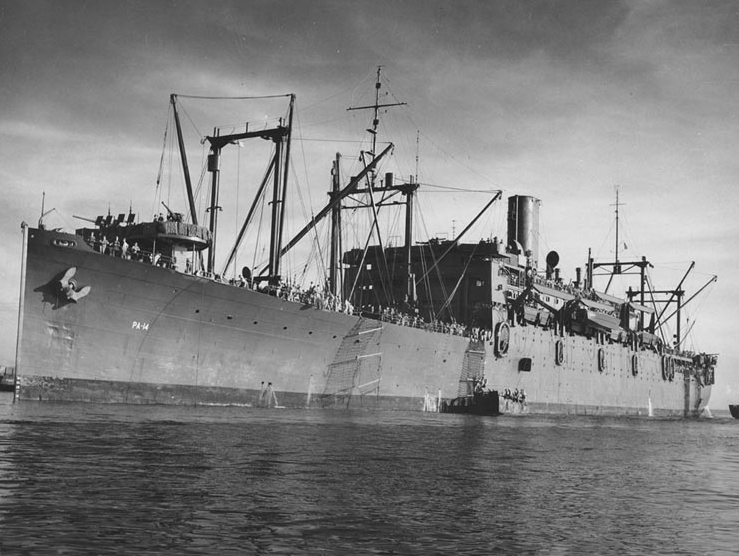
USS Hunter Ligget, ex- SS Pan American (APA 14) circa 1944.
USS Harris, Hunter Ligget, Tasker H Bliss, Hugh S. Scott. (Dickman) USS J.T. Dickman, Henry.T. Allen, J. Franklin Bell, American Legion.
Codenamed APA-2, 14, 42, 43, 13, 15-17 these were ex “President” class Hog islander of WW1 type freighters. They were built in 1919-1922 to the initiative of the US Shipping Board as the “535 class” to act as troop transport in wartime and regular commercial vessel in peacetime, fleet auxiliaries. From 1923 to 1937 they were indeed released from the Navy and used for trade, until requisitioned in 1939 and used by the Army, and passed onto the Navy in 1947, converted as attack transports (APA).
Converted in 1940, they were fairly large, displacing 21,300 tonnes fully laden, while still relatively fast with their turbines, able to reach 17 knots. Dickman class (converted 1942) was different:
Of the same size, they were larger at 22 m (72ft 4in) but with lesser draught at 9.22 m (30ft 3in). They were also less powerful at 10,000 shp for 16.5 knots. They also carried less LCVPs, 22 rather than 30. They participated in most amphibious operations in the Mediterranean, Atlantic and Pacific Theatres. Due to their age they were decommissioned in 1946 and scrapped in February–March 1948.

Harris class profile (navypedia)
Specs:
Tonnage: 21,000 T FL
Dimensions: 163.12 x 21.95 x 9.3m (535 x 72 x 30 ft)
Machinery: 2 shafts Bethlehem Turbines, 8 boilers, 12,000 shp, 17.5 knots
Armament: 6x 40 + 10×2 20 mm AA
Boats carried: 33 LCVPs, 2-4 LCM(3)
Payload: 400 tons cargo/1650 infantry
Crew: 472
McCawley class attack transports (1940)
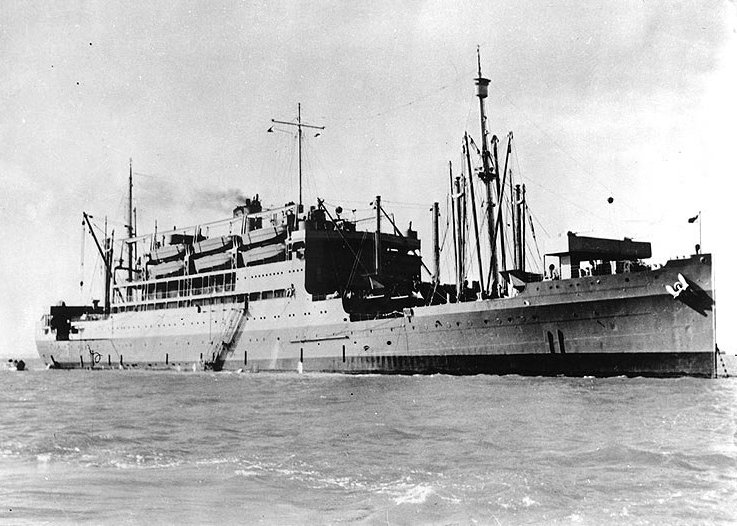
Of note also were the two McCawley-class attack transports (1940):
These 1928 commercial passenger/freighters (Grace lines) were requisitioned and transformed in 1940, of the earliest US Navy attack transport, which carried integral landing craft and AA defense. They measured 486 ft 6 in (148.29 m) by 63 ft 6 in (19.35 m) for a draft of 25 ft 6 in and were propelled by two 8-cylinder, 2-cycle Sulzer diesel engines, with a shaft horsepower of 8,000, enough for a top speed of 15-17 knots. They carried 1,207 infantry (plus 80 officers) and 164,561 cu ft (4,659.8 m3) of cargo, and were armed with four 3″/50 caliber DP guns, two twin 40 mm Bofors and 18 single 20 mm oerlikon guns. Only two ships of this class existed, USS McCawley (AP-10) and USS Barnett (AP-11). They saw action at Guadalcanal and the Pacific Theatre. USS McCawley was later sank by error by US Navy PT boats on the night of 30 June 1943. USS Barnett went to the western theater and participated i the invasions of Sicily, Italy, Normandy and Southern France, then back to the Pacific (Okinawa).
Penn/Middleton class attack transports (1942)
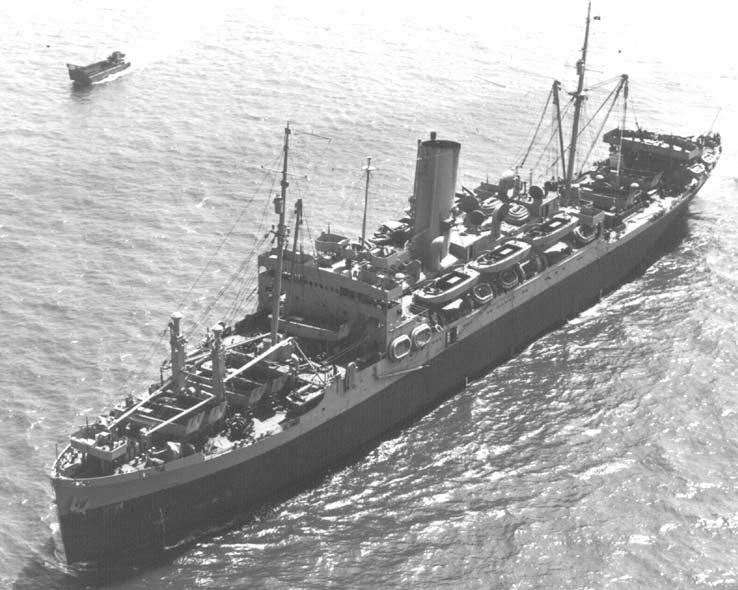
USS John Penn (AP 51) in 1942
USS John Penn
USS John Penn was the ex-Excambion (1931) NY Shipbuilding Company of Camden (New Jersey), of the “Four Aces”, acquired by the Navy 8 January 1942, transformed and commissioned 6 April 1942 with Captain Harry W. Need in command. Her specs were a 9,360 tons displacement light, 475 ft 4 in (144.88 m) x 62 ft (19 m) x 26 ft (7.9 m), propelled by a Steam turbine and armed with a single 5″/38 caliber (127 mm), 4 × 3″/50 (75 mm) cal. guns and 8 × 20 mm AA guns. She served in Operation Torch, and made the Guadalcanal campaign but was sunk off Lunga Point by IJN aviation, 13 August 1942.
Arthur Middleton-class attack transport
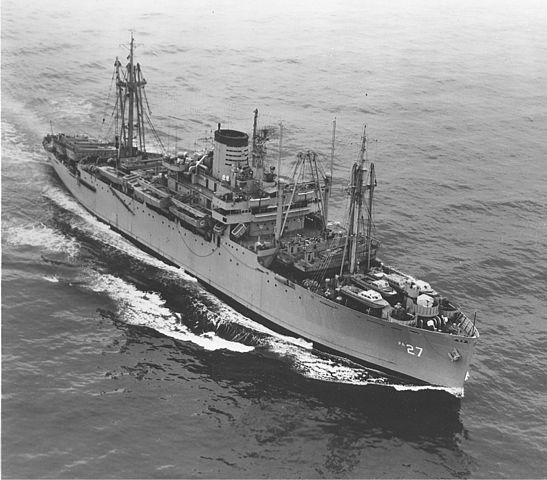
A.Middleton, Samuel Chase, George Clymer
These three ships were ones of the rare purpose-built attack transports, named after signatories of the American Independence. They were built beflre the war, on 1st July 1940 and completed on 7 September 1942 with a MCV hull type C3-P&C. Arthur Middleton and George Clymer served almost exclusively in the Pacific Theatre until Okinawa. Samuel Chase participated in the invasions of North Africa, Sicily, Italy and Normandy before beng sent to the Pacific. They were still in action during the Korean and Vietnam wars, retired in 1967-73, gaining many battle stars in between them.
Specs Middleton class:
Tonnage: 9,000 tons – 16,800 tons FL
Dimensions: 491 ft x 69.6 ft x 26 ft 6 in
Machinery: 1 prop, General Electric geared turbine drive, 2 Foster Wheeler D-type boilers 8,500 hp (6,300 kW), 18.4 knots
Armament: Var. 5″/38, 4× 3″/50, 8× 40mm guns, 0-10× 20mm AA, 4× .50 cal. MGs
Boats carried: Unknown
Payload: 200,000 cu ft, 2,700 to 3,500 tons
Crew: 480 crew + 1446 troops.
Doyen class attack transports (1942)
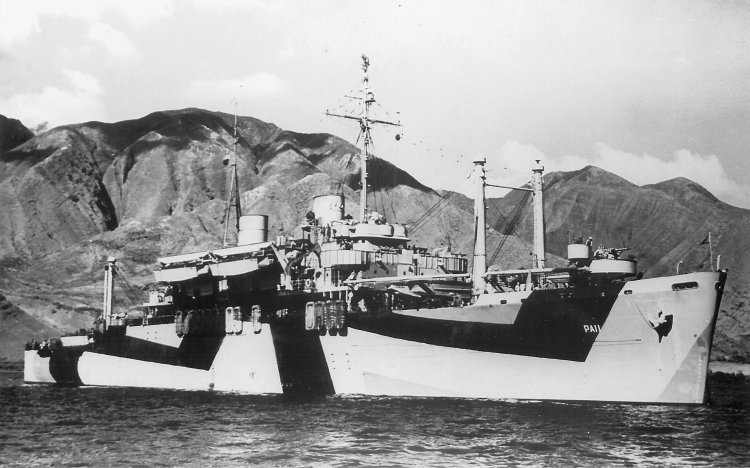
USS Feland
USS Doyen, USS Feland.
Two ships, specifically built as attack transports, between early 1942 and June 1943, based on the Maritime Commission’s P1 hull type (P1-S2-L2) in California (Consolidated steel). Planned in 1940 already they were designed to carry a battalion of the Marine Expeditionary Force in peacetime. They were relatively small, yet their troop carrying capacity was found adequate at 1,100. They had Westinghouse turbines and Babcock & Wilcox boilers.
Both served in the Pacific, and often together, at Tarawa, Saipan, Guam, Luzon and Iwo Jima. USS Doyen was also sent in Kiska (Aleutians) and Kwajalein. They earned collectovely 11 battle stars. After the war, they participated in Magic Carpet, decommissioned in March 1946, laid up in the National Defense Reserve Fleet. USS Doyen became in 1959 TS Bay State, the training ship of the Massachusetts Maritime Academy, decomm. in January 1974 and resold.
Specs APA-1, APA-11:
Tonnage: 4,351 tons – 6,720 tons FL
Dimensions: 127.34 x 17 x 5.8m (414 x 56 x 19 ft)
Machinery: 2 shaft Geared turbines, 8,000-8,800 hp, 19 kts.
Armament: 4× 3″/50 DP, 2×2 40, 8x 20mm AA.
Boats carried: 16 LCVPsin 1945
Payload: Unknown
Crew: 450 crew + 1100 troops.
Windsor/Funston class attack transports (1943)
Windsor, Leedstown, Adair, Dauphin, Duchess, Queens, Shelby. Funston, O’Hara, Griggs, Grundy, Guiford, Stika, Hamblen, Hampton, Hannover.
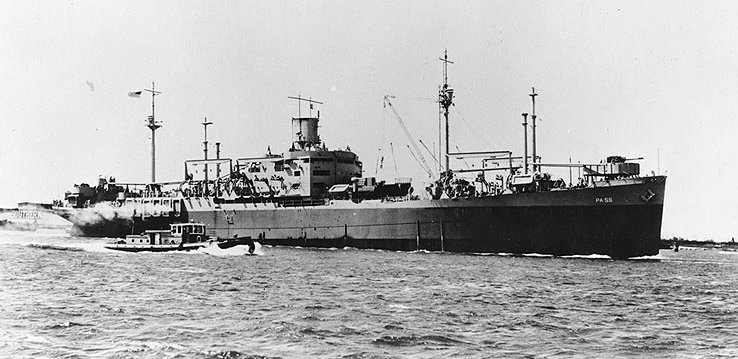
The first class (Windsor) comprised nine ships, apparently based upon three variants of the Maritime Commission’s ubiquitous C3 cargo type. They entered service between 1943 and 1945.
They can carry 150,000 cu ft (4,200 m3), 1,600 tons and were armed with a single 5″/38 caliber dual-purpose gun mount completed by light AA. It varied in fact between ships.
In action, the Windsor class served exclusively in the Pacific. USS Windsor and Leedstown (APA-55 and 56) commissioned by mid-1943 earned collectively at least five battle stars. The others were in July 1944 and remaining five were too late to see combat. They were used for transport and training. They transported fresh occupation troops to Japan, China and Korea and repatriated troops (Operation Magic Carpet) before being demobilized in early 1946 and sold to commercial service, scrapped for the most in the early-to-mid-1970s apart the USTS Texas Clipper (decomm. 1995 sunk as artificial reef 2007).
Specs (Windsor):
Tonnage: 13,200 T FL
Dimensions: 144.20 x 20.12 x 7.62m (473 x 66 x 25 ft)
Machinery: 1 shaft Bethlehem Turbine, 2 B&W boilers, 8,000 shp, 17.5 knots
Armament: 8x 40mm, 24x 20 mm AA
Boats carried: 21 LCVPs, 2 LCMs, 1 LCP(L), 1 LCP(R).
Payload: 300 tons cargo/1468 infantry
Crew: 466
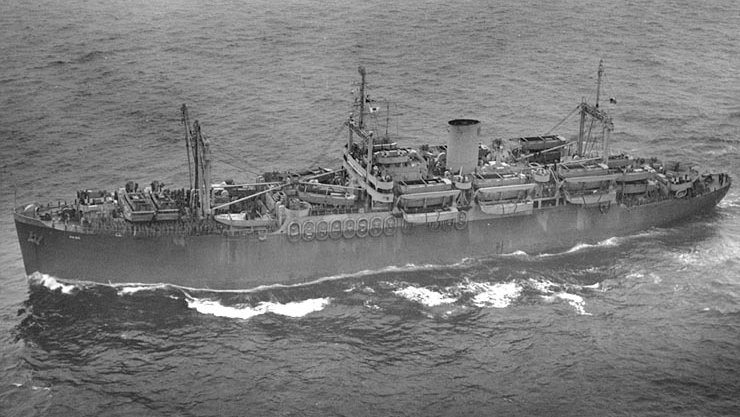
James O’Hara of the Funston class in the Atlantic, 1943
The second class (Funston) was also based on C3 class cargos. The name came from the US Army General Frederick Funston, a veteran of the Philippine–American War, awarded the MoH. Only two ships at first, based on the Maritime Commission’s C3-S-A1 hull. They were acquired after some commercial service by the US Navy, recommissioned in april 1943, reclassified APA. They were smaller at 7,000 tonnes,slower at 16.5 knots but carried about 2,200 infantry, and were arme with a single 5″/38 dual-purpose gun (127 mm), two 3″/50 (75 mm) dp guns, two quad 1.1″/75 (28 mm) AA guns, later replaced by sixteen single 20mm gun mounts. In service they participated in Mediterranean opeations: Invasion of Salerno, but were soon sent in the Pacific Theatre. After the war they became US army transport or USAT (US Army Transport), then reacquired by the Navy (T-AP) and used as transports in the Korean War, scrapped 1968-69. They never returned to civilian service.
Specs (Funston):
Tonnage: 7,000/8,600 T FL
Dimensions: 150.16 x 21.18 x 8m (492 x 69 x 26 ft)
Machinery: 1 shaft Bethlehem Turbine, 2 B&W boilers, 8,000 shp, 16.5 knots
Armament: 127, 75 mm guns, 16x 20 mm AA
Boats carried: 21 LCVPs, 2 LCMs, 1 LCP(L), 1 LCP(R) ?.
Payload: 400 tons cargo/2200 infantry
Crew: 570
Ormsby(Sumter) class attack transports (1942)
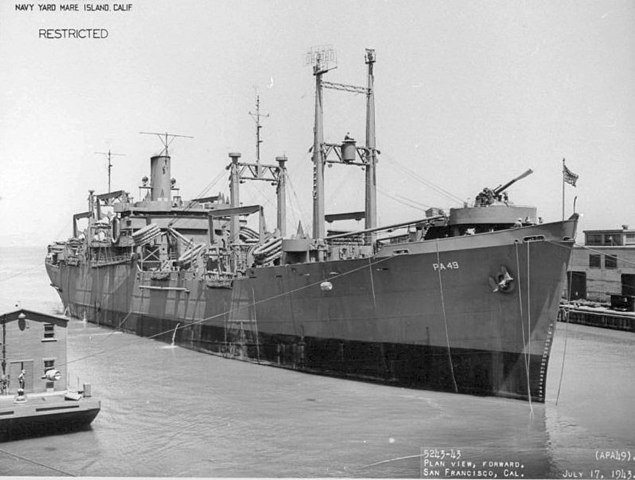
USS Ormsby, Pierce, Shridan (APA 49, 50 and 51)
Like many other APA vessels (attack transport), these three ships were based on the Maritime Commission prewar C2-S-B1 type hull. They had been specifically designed for Naval auxiliary service in wartime. Not very large, they received more AA than most transports of their day, being commissioned on 28 June 1943. By that time they were armed with two 5 inches/38 dual-purpose guns, two single and four twin Bofors 40 mm guns, and up to 22 20mm guns, but the latter were gradually replaced by more 40 mm Bofors, more efficient.
in action, they were quite active, used exclusively in the Pacific, from the Gilbert Islands campaign up to Okinawa. Between them they won 18 battle stars, and participated to Magic Carpet until 1946, decommissioned and scrapped after civilian service in the late 1960s.
Specs (Ormsby):
Tonnage: 7,000/13,910 T FL
Dimensions: 140 x 19 x 7,3m (459 x 63 x 24 ft)
Machinery: 1 shaft GE Turbine, 2 FW boilers, 6,000 shp, 16.5 knots
Armament: 2×127, 10×40 mm guns, 16-22x 20 mm AA
Boats carried: 21 LCVPs, 2 LCMs, 1 LCP(L), 1 LCP(R) ?.
Payload: 2,700 tons cargo/1,470 infantry
Crew: 46+478
Bayfield class attack transports (1942)

34 ships (Conway 29): Bayfield, Bolivar, Callaway, Cambria, Cavalier, Chilton, Clay, Custer, Du page, Elmore, Fayette, Fremont, Henrico, Knox, Lamar, Alpine, Barnstable, Burley, cecil, Dade, Medocino, montour, Riverside, Westmoreland, Hansford, Goodhue, Goshen, Grafton (APA-33-48, 92, 93, 95, 96, 99-102, 104, 106-109).
The Bayfield is the first “superclass” of armed transports, whereas most classes were limited to 2-5 ships at the most.
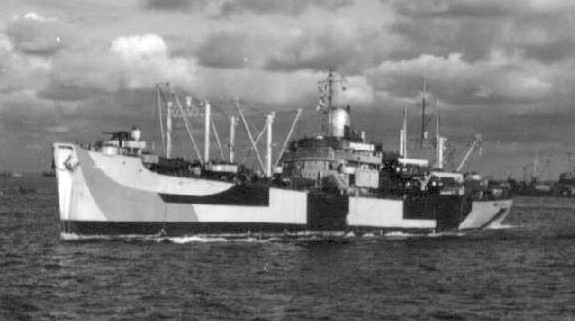
USS Knox APA-66 with a dazzle camouflage in 1943
They were based on the large Type C3 passenger/cargo ship, along the standard setup by the US Maritime Commission (1938), better known as C3 standard. They were designed to produce modern and good quality versatile ships to replace an ageing US merchant fleet. On top of this, they were deigned with a future use as Navy auxiliaries in mind, with an easy and quick convertion. Nevertheless, in 1941 the need for transport shis was so great that types that could be manufactured quicker were preferred, such as the Haskell class based on the Victory ship design, making an even larger class.

USS Hamblen APA 114
By design, they were not symmetrical, having 2/3 of their load forward, 1/3 aft and a massive island, fir to carry passengers as well. In order to accommodate troops, two cargo holds amidships were converted into accommodation facilities, using prefabricated floors and walls. Each hold therefore became three decks, tall enough for tiered five high bunks beds, with passageways in between.
Each bunk was only thirty inches wide. Fortunately, the soldiers crowded the decks during the day, as the heat in the pacific could become unbearable below.
Troops were provided with their own galley and mess hall, completely separate from the crew, without dining hall so they used their own mess to eat where they could. these ships also had a sick bay and dental clinic to provide carre during the trip. The troop commander however had his own private cabin and office and he had a loudspeaker system. Music and other entertainment were often piped to the troop compartments. This design was particular in that concrete was used as ballast in the bottom of the cargo holds.
Like most cargoes of that time they had a single propeller, but a steam geared turbine fed by two D-Type boilers to reach at least 17 knots (18 in that case), which was largely enough to evade a submerged U-Boat. Alas, the latter often attacked by sneaking in the middle of the con and voy by night, using their surface speed of 17.7 knots.
They were bristling with davits of all types, to carry in general the following combination of landing crafts: 12 LCVPs, four LCM and three LCP(L). They could carry internally and externally up to 4,500–4,800 tons of cargo which represented 175,000 to 200,000 cubic feet. They carried 51 officers and 524 sailors, with in addition 43 officers and 108 men as flagships and a batallion, 80 officers and 1,146 privates. So in full capacity they carried as flagship up to 1952 men.
They were armed with two single 5 inch 38 caliber dual purpose guns, one fore and one aft in large bathtub like platforms with a good arc of fire, two to four twin 40 mm Bofors, two quad 1.1″/75 (28 mm) “Chicago Piano”, replaced by 40 mm in late 1943 or 1944, two single 40 mm AA Bofors and 18 (or more) 20 mm Oerlikon guns. Conway’s figure states four twin Bofors and twleve twin 20 mm AA, which could be an error, twin 20 mm were rarer, fitted with Handle Bars Mk 8 Mod 0.

Bayfield class schematics, ONI

USS Cambria (APA-36) Src – purchase
Specs (Bayfield 1945):
Tonnage: 9,000/16,100 T FL
Dimensions: 150 x 21,18 x 8,08m (492 x 69 x 26 ft)
Machinery: 1 shaft GE Turbine, 2 FW boilers, 8,500 shp, 18 knots
Armament: 2×127, 8×40 mm guns, 24x 20 mm AA
Boats carried: 26 LCVPs, 2 LCM(3)
Payload: 5,500 tons cargo/1,500 infantry
Crew: 51+524, see notes.
Sumter class attack transports (1942)
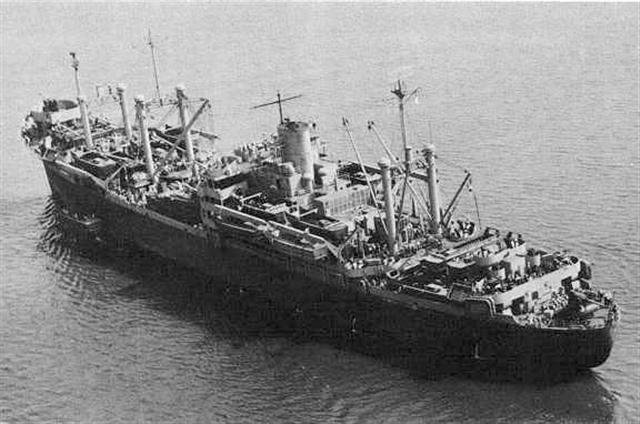
USS Sumter, Warren, Wayne, Baxter (APA-52-54 & 94)
Often associated with the Ormsby class (they were grouped in Conways) but converted later in 1943, they were very similar, and counted four ships. They were all built by the Gulf Shipbuilding Corporation, at Chickasaw, Alabama, and used at first as transports, based on a C2-S-E1 type hull, laid down in April 1942, and the fourth in March 1943; They were requisitioned to be converted as attack transports at Bethlehem Steel, Maryland Drydock or the Atlantic Basin Iron Works and commisioned as APA ships 4-6 months afterwards.
They were slightly slower, with a single propeller shaft, propelled by a General Electric geared-drive turbine, fed by two Babcock & Wilcox header-type boilers for a designed shaft horsepower of 6,000. They carried 91-95 Officers and 1,340-1,472 Enlisted men, plus about 170,000 cu ft of cargo of 1,300-1,450 tons of payload. They deployed LCVPs and LCM(3)s from their davits (details unknown).
They were used in the Pacific, and USS Wayne was the most decorated, earning seven battle stars.
Specs (Sumter):
Tonnage: 8,591/13,910 T FL
Dimensions: 469 x 63 x 23 ft
Machinery: 1 shafts GE GD turbine, 2 B&W boilers, 6,000 shp, 16.5 kts
Armament: 2x 5-in, 4×2 40mm, 10x 20mm AA
Crew: 600 + 1400 troops
Andromeda class attack cargo ships (1943)
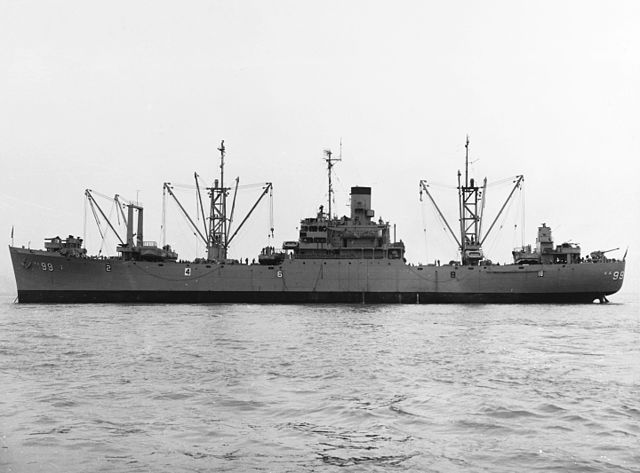
An Andromeda-class attack cargo ship were 30 vessels by Federal Shipbuilding & Drydock Co. in Kearny, New Jersey, and Moore Dry Dock Co., in Oakland, California. They were based on standad C2 hulls (exactly C2-S-B1 type). However they are associated to the Arcturus and Tolland sub-classes for clarity, making a grand total of 62 ships. They were propelled by a single shaft, connected to the General Electric turbines in most cases, fed by two Combustion Engineering boilers for a total of 6,000 shp and 16 knots. They also carried 1,553 tonnes of oil.
There were some differences from ship to ship, notably the armament. In 1944–1945, their 5″/38 was standard for both AA and naval gunfire support and gradually the 40 mm replaced also the 20 mm and even older .50 caliber guns. They carried 4450 tonnes of cargo and in 1945 in general, 15 to 16 LCVPs, 8 LCM(3)s, and a single LCP(L). They mostly served on the Pacific, some earning many battle stars in the process.
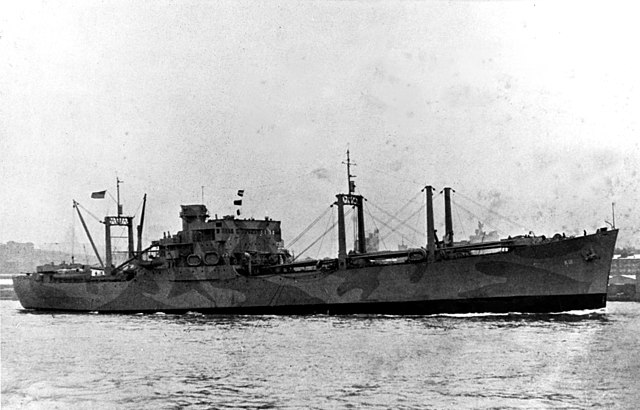
USS Arcturus (AK-18) in late 1942. Often associated, these ten ships (Arcturus class) were built earlier by the Sun Shipbuilding & Drydock Co. in Chester, Pennsylvania, Tampa Shipbuilding Co. in Tampa, Florida, and Federal Shipbuilding & Drydock Co. in Kearny, New Jersey, under the type S4-SE2-BE1.
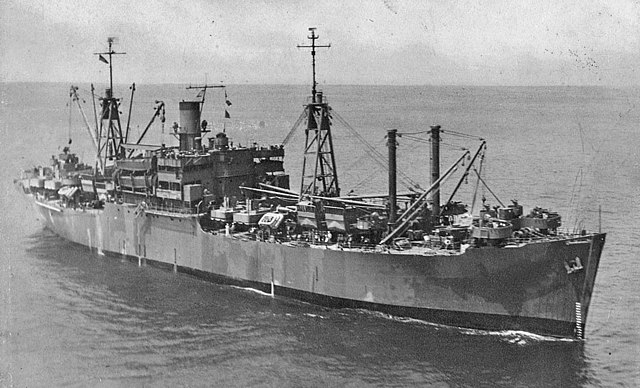
Tolland sub-class: Also associated by their identification numbers, AKA-64 to 109, for a total of 32 ships. They were built by North Carolina Shipbuilding Co. in Wilmington, North Carolina in 1944. Specifications and general arangements were about the same.
Specs (Andromeda):
Tonnage: 6,761/12,000 T FL
Dimensions: 140 x 19 x 8 m (459 x 63 x 28 ft)
Machinery: 1 shaft turbine, 2 boilers, 8,000 shp, 18 kts
Armament: Variable, 1x 5-in, 4×2 40mm, 10x 20mm AA, see notes
Crew: 247-404 + 1400 troops
Haskell class attack transports (1943)
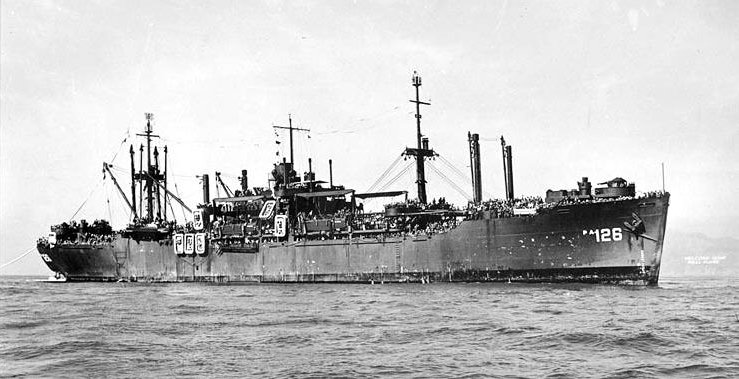
By far the largest, most ambitious class of assault ships designed in the Unites States: In all, 131 were ordered from California Shipbuilding, Oregon Shipbuilding, Permanente Metals and Kaiser Shipbuilding, and 117 delivered before the war ended, the other cancelled. They were all named after state counties.
They were based on the much simplified victory ships, with the Maritime Commission standard type VC2-S-AP5. Construction started in 1944, so few saw real active service in the pacific where they all served (see later). The serie started with the lead ships, USS Haskell (APA-117) until APA-247, with some repurposed as hospital ships in between (but cancelled for C4 hulls, while they were resold to civilian users). In all, 14 were cancelled at V-Day. Their career wa not limited to WW2, any served long years afterwards as assault ships. The first was commissioned on 11 September 1944 and the last on 29 October 1945.
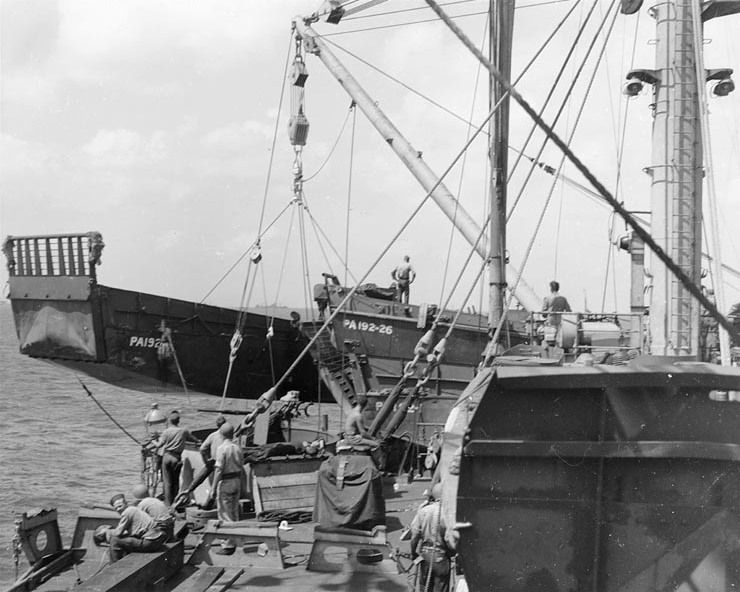
USS Rutland lowering LCMs
They were propelled by basically the same powerplant than for the victory ships: A single propeller, and geared turbine (Westinghouse, Joshua Hendy or Allis-Chalmers), fed by the supeheated steam from two header-type boilers (Babcock & Wilcox or Combustion Engineering). It delivered in total about 8,500 shp (6,338 kW), enough to provide 18 to 19 knots (33–35 km/h; 21–22 mph), by far the best speed of any other assault ships.
They were designed to carry 1,500 troops and their equipments, and 25 landing craft: Typically twenty-three 36-foot (11 m)-long LCVP, two LCM (3), and a gig. In other configurations they carried
two LCM, 12 LCVP and 3 LCPL. Armament was still consequent to face mostly aviation, covering all ranges: One 5″/38 caliber gun on the forecastle, twelve Bofors 40 mm guns (single quad, four dual mounts), and ten Oerlikon 20 mm guns.
In action, few of these ships arrived in time for assisting in the final operations in the Philippines, Iwo Jima and Okinawa. USS Hinsdale (APA-120) was severely hit by a Kamikaze on 1st April 1945, as USS Telfair (APA-210) a day after, but both were repaired later. USS La Grange (APA-124) had the same fate in August 1945 while USS Colbert (APA-145) hit a mine on 17 September 1945, also off Okinawa. None was sunk. The remainder of the order were just mothballed, waiting for an assignation. After Operation Maic carpet, some served in Korea, but other were deactivated and resold to civilian users. While most were scrapped in 1973–75, a few were converted into Missile Range Instrumentation Ships (MRIS). The last in existence were USS Gage, still in her original Haskell configuration (scrapped 2009) and USS Range Sentinel (ex-Sherburne), converted as MRIS, used until 2012. She was the very last.
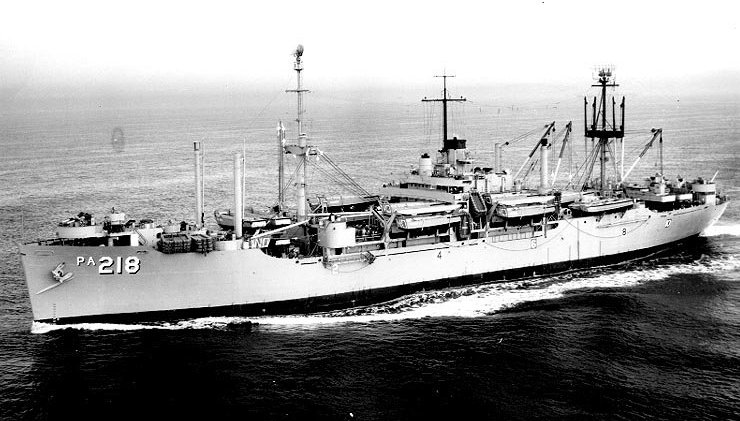
USS Noble, APA-218 in 1956
Specs (Haskell):
Tonnage: 6,800/14,800 T FL
Dimensions: 139 x 19 x 7 m (455 x 62 x 24 ft)
Machinery: 1 shaft turbine, 2 boilers, 8,500 shp, 18-19 kts
Armament: 1x 5-in, 4×2 40mm, 10x 20mm AA, see notes
Crew: 900 + 1400 troops
Gilliam/Artemis class attack transports (1944)
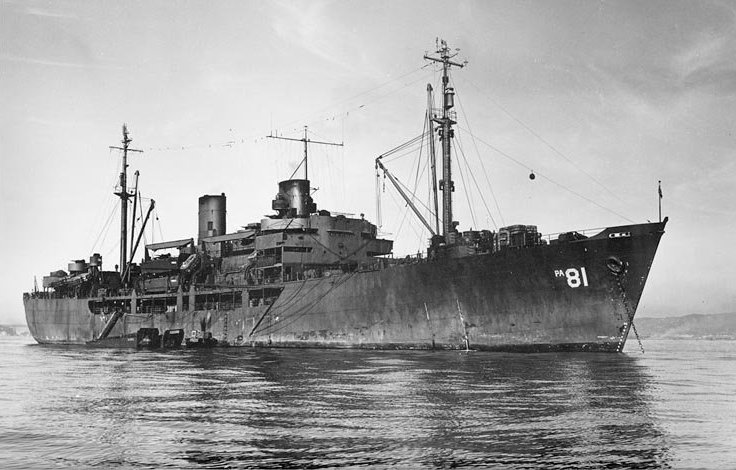
Gilliam, Appling, Audrain, Banner, Barrow, Berrien, Bladen, Bracken, Briscoe, Brule, Bruleson, Butte, Carlisle, Carteret, Catron, Clarendon, Cleburne, Colusa, Cortland, Crenshaw, Crittenden, Cullman, Dawson, Elkeheart, Falon, Fergus, Filmore, Garrard, Gasconade, Geneva, Niagara, Presidio
This was the second large production “superclass” of armed assault transports (APA) of the US Navy, all very similar. To achieve that scale, these were based on the San Francisco naval architects Joslyn and Ryan’s Maritime Commission Type S4-SE2-BD1. In all 32 vessels (combined with the Artemis sub-class) were built under MARCOM contracts by the Consolidated Steel Corporation (Wilmington, California). The very first, USS Gilliam (APA-57), was launched on 28 March 1944 and was commissioned on 1 August 1944. So the bulk of the class, albeit they were faster and cheaper to built than the Bayfield class, arrived late in the war, many were completed as the war already ended. They were the last of the “great four” attack transport classes, Bayfield, Haskell, and Andromeda.
Design-wise, they looked sleek and modern compared to earlier vessels, notably thanks to a clipper bow, fine lines, a powerful Westinghouse turbo-electric transmission fed by 2 boilers on twin propellers, over a design shaft horsepower of 6,000, enough to go beyond 17 knots comfortably.
They were crewed by 27 Officers and 295 Enlisted, and carried 47 Officers and 802 Enlisted plus a useful cargo payload of 85,000 cubic feet or from 600 to 2,600 tons (1,032 for conways).
They were armed with a single 5″/38 caliber dual-purpose gun (127 mm) and four twin 40 mm gun mounts completed by ten single 20 mm gun mounts, and carried in 1945 typically 13 LCVPs, and a single LCP(L).
The Gilliam class missed the hardest part of the island hopping campaign, but the earliest saw action during the late Philippines campaign, landing troops at the Battle of Luzon, on the beaches of Iwo Jima and Okinawa. More than assault, most made just troop transport cargo and supplies missions at the end, ad after the war. They all participated in Operation Magic carpet in 1946. Some were blasted during Operation Crossroads. The remainder were all resold to civilian onwers.
Specs (Gilliam):
Tonnage: 4,087 tons, 6,740 T FL
Dimensions: 129,85 x 17,68 x 4,72 m (426 x 58 x 15ft)
Machinery: 2 shafts, 1 GE GD turbine, 2 boilers, 8,000 shp, 18 kts
Armament: 1x 5-in, 4×2 40mm, 10x 20mm AA
Boats: 13 LCVPs, 1 LCP(L)
Crew: 283 + circa 850 troops
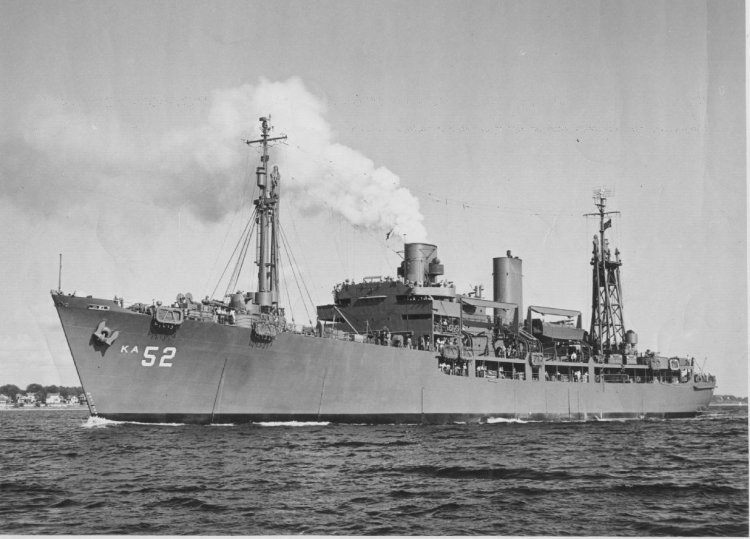
USS Zenobia
The Artemis sub-class comprised the USS Artemis, Athene, Aurelia, Birgit, Circe, Corvus, Devosa, Hydrus, Lacerta, Lumen, Medea, Mellena, Ostara, Pamina, Polana, Renate, Roxane, Sappho, Sarita, Scania, Selinur, Sidonia, Sirona, Sylvania, Tabora, Troilus, Turandot, Valeria, Vanadis, Veritas, Xenia and Zenobia.
They were basically similar, but designated AKA because considered “combat loaded”. With reinforced davits, they lowered their landing crafts already fully loaded, combat ready. Thus, despite a lower capacity they were much faster and safer in amphibious operations.
Appalachian class command ships (1943)
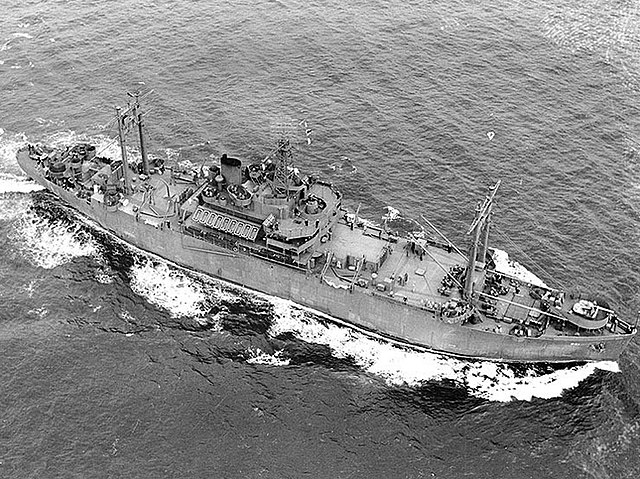
Appalachian, Blue ridge, Rocky Mount (ACG-1-3), USS Catoctin (ACG-5)
All three were built by the Federal Yard at Kearny. They were former troop transports converted as command ships with headquarters and air control facilities, in order to coordinate emphibious Operations; They became so precious that numerous ships were so converted: In 1944 for example, the four ex-treasury cutters, coast guards in the Atlantic, were converted as additional ACGs, as well as the ex-seaplane tender USS Biscayne became ACG-18, or the ex-transport USS Ancon (see below).
The Appalachian class were based on C2-S-B1 hulls.
They had a raised superstructure to house the HQ and its facilities, and a new lattice mast to support antennae and radars.
Specs (Appalachian):
Tonnage: 13,710/13,910 T FL
Dimensions: 139.98 x 19.20 x 7.32m (459 x 63 x 24 ft)
Machinery: 1 shaft Bethlehem Turbine, 2 B&W boilers, 6,600 shp, 17 knots
Armament: 2x 5in (127 mm), 8x 40 mm, 20x 20 mm AA
Crew: 507 + 368 HQ Personal
USS Ancon (ACG-4)
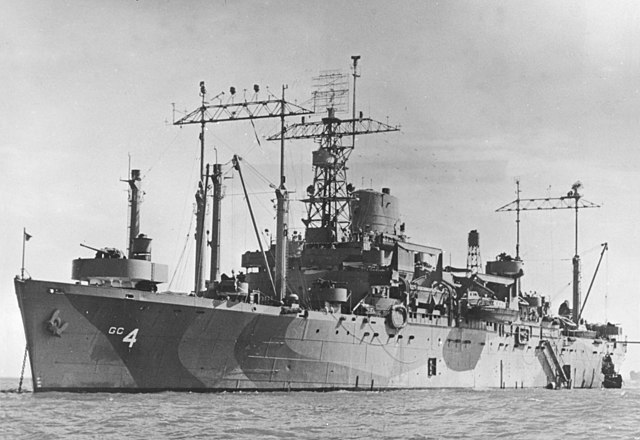
Independent of this class, ACG-4 was one of three identical ships built for the Panama Railroad Company (1938), requisitioned by the Army Transport Service in January 1942 for troop transport, then requisitioned to be converted in San Francisco during June and July 1942, for the needs of the Navy on 7 August 1942, commissioned on the 12th. She served in the Mediterranean from Operation Torch to the Invasion of Italy, Nomandy, and the Pacific. Specs: 14,150 tons, 493 ft (150 m) x 64 ft (20 m) x 26 ft 3 in (8.00 m), propelled by two steam turbine (9,166 shp, 18 knots), crew 707, armed with two 5 in, four twin 40 mm, fourteen 20 mm AA, extended radio communication equipments and radar, HQ facilities. She was Mark Clarke Floating HQ during operation Avalanche, until the German counter-offensive.
Mount Mc Kinley class command ships (1944)
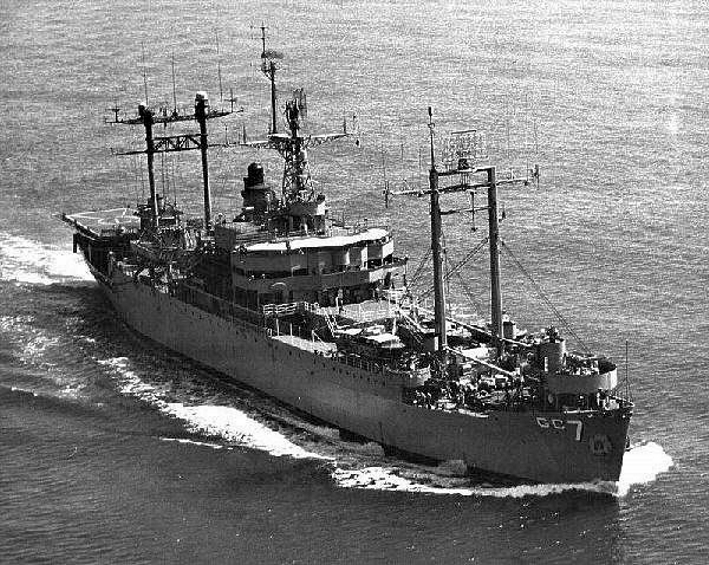
USS Mount McKinley, Auburn, Eldorado, Estes, Paramount, Teton, Adirondack, Pocomo, Taconic (ACG-7-17).
Essentially similar to the former Appalachian, they were based on maritime commission design C2-S-AJ1 hulls. Rebuilt with one full deck height structure, between the forward and after kingposts, new lattice mast stepped on the superstructure for a large air search radar, and most were fitted with a height-finding radar for fighter coordination and guidance. It was placed on top of one leg of the forward kingpost. The latter were of the “H” type indeed.
Specs (McKinley):
Tonnage: 12,550 T FL
Dimensions: 139.96, same (459 ft 2 in)
Machinery: same
Armament: same
Crew: 622 + 441 HQ Personel
APD1 light attack transports conversions (1942-43)
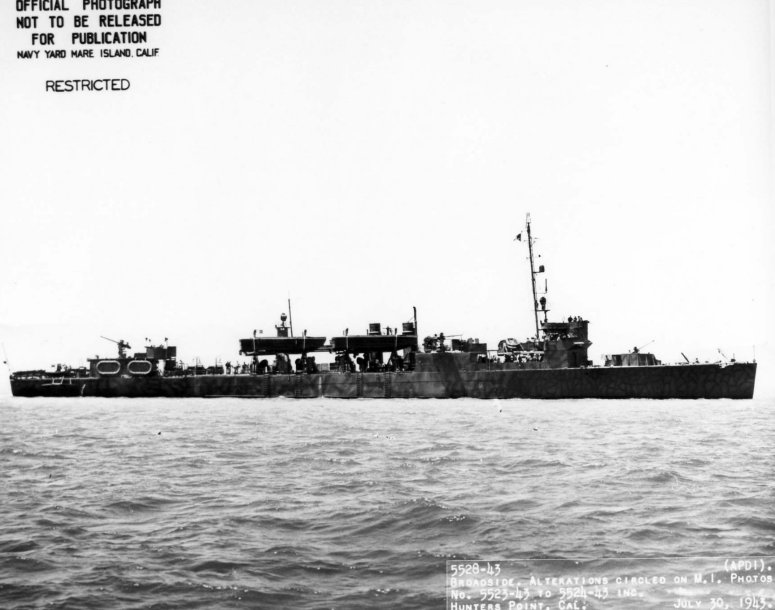
APD-1 off hunters point, California, departing for in Guadalcanal in July 1943.
The immense fleet of “flush-decker”, “four-pipers” built from 1917 in the USA to escort the fleet and participate to the battle of the Atlantic were mostly mothballed after the war, some completed as late as 1921. They were fast, well armed, but not fit for heavy weather. Reactivated after December 1941, with 50 set to the Royal Navy, they were used as escort in part, but other were converted for other roles sue to their obsolescence as destroyers: Seaplane tenders, destroyer minelayers and minesweepers. Last in the list, was the idea to convert them as high speed transports. High speed they were, on paper, with 33 knots on average. But thir machinery was gutted to make room for accomodations, so that they ended as 25 knots vessels with just two smokestacks. The first group of converted ships was called APD-1 through APD-36. There was a single Caldwell-class destroyer, 17 Wickes-class, and 14 Clemson-class.
In addition to their machinery modifications, they received accommodation for 200 troops in these former engine space and the armament as replaced by three 3″/50 dual-purpose guns, one 40 mm AA gun, and five 20 mm AA guns plus two depth charge racks, six K-gun depth charge throwers to retain ASW capabilities. Torpedo mounts were replaced by large davit, which were to drop at sea four LCPLs, and later in the war, LCPRs, which had a ramp. For their service as “Marines Taxis” in late 1942 throughout 1943 in the Carolines, they were nicknamed the “green devils”. They were indeed mostly used in the gruelling Guadalcanal Campaign. Both sides tried to reinforce their side by using night high-speed transports. These early APDs performed well in general. In addition to carry troops to beachheads and support them with their own artillery on demand, bringing supplies, they served as escorts for other transports and supply vessels. They provided also anti-submarine patrols. But thy mostly gained fame with the action of the Underwater Demolition Teams (UDTS) and commando units. Many were lost in action as well, but the remainder gained scores of battle stars.
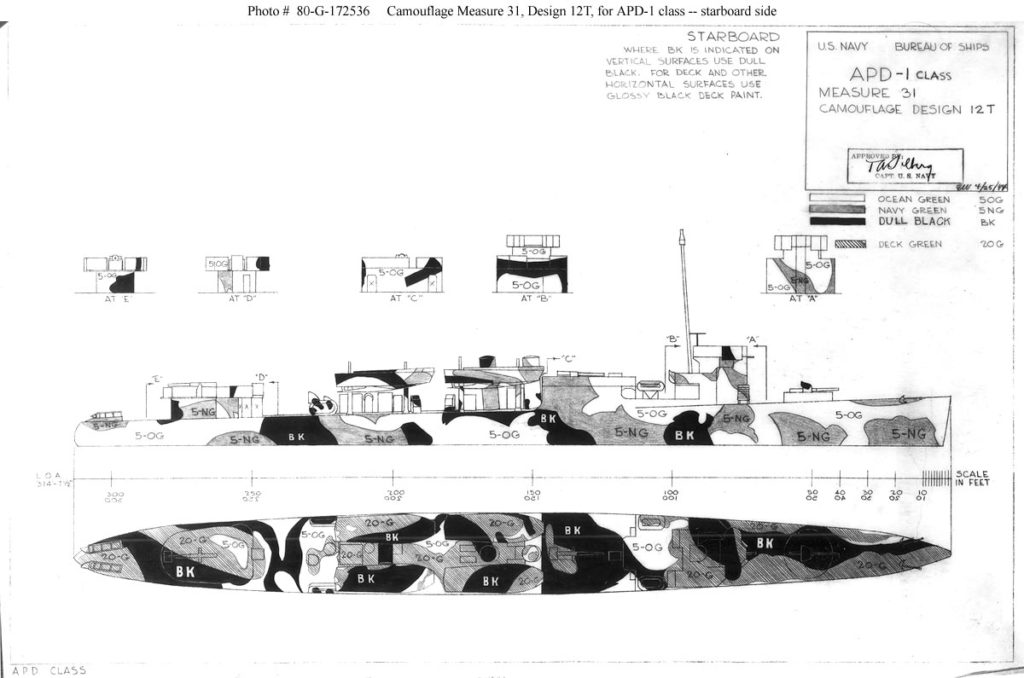
Measure 31, design 12T planned for the APD-1 serie. In reality they were many local adaptations of the design. most pattern were made of shades of green to blend in the environment.

Author’s illustration of the USS Barney
Specs (APD-1):
Displacement: 1315 t ST, 1793 t FL
Dimensions: 95.71 x 11.28 x 3.7 (314 x 37 x 12 in)
Machinery: 2 shaft turbines, 2 boilers, 13,000 shp, 24 knots
Range: Oil 429 t, 5,500 nm at 12 kts
Armament: 3-3in/50, 2x 40 mm AA, 5x 20 mm AA, 4 DCP, 2 DCR
Boats carried: 4 LCVPs, 144 troops
Crew: 101
APD37 class light attack transports (1943-45)
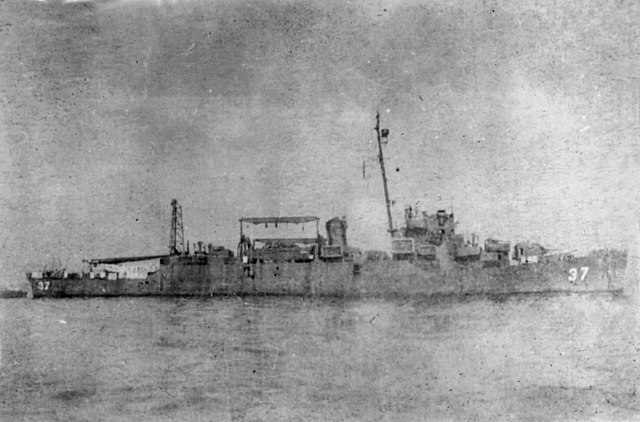
While the assault cargo ships we have seen were slow and ponderous, there was an emergency wartime conversion that was intended to bring less troops, but much faster and in a more stealthy and weaponized way: The APD series. These were called “high speed transport”, and converted in 1944 from former destroyers escorts of several types. These were of the TE/TEV types (Buckley and Rudderow class) and were numbered APD-37 to 68, 75-86 and APD 139. Why not starting with APD-1 you ask ? Because before them, vintage 1919-21 four-funneled destroyers were already converted, APD-1 to APD-36, the famous “green dragons” of Guadalcanal (see above). They served as models for the latter, but the main difference was their conversion was long after their use as destroyers, while most of the APD-37 series, 43 ships in all, were converted on the stocks, never completed as destroyer escorts. They had basically their section aft of the funnel modified to carry large davits, capable of putting at sea two LCVPs each. Troops capacity in all therefore was 162 Marines, while their supplies were stored on the aft deck. There were also ready gasoline tanks for vehicles.
But in both cases, the mission was the same: Carry land raiding parties or support underwater demolition teams claring beach obstacles, mostly by night. Since part of their original armament and control systems were kept, they were also used as escorts for the amphibious groups notably for ASW purposes, keeping their sonar and grenades. Visually the ships only differed by their base type, TE or TEV, recoignisable by their different bridge.
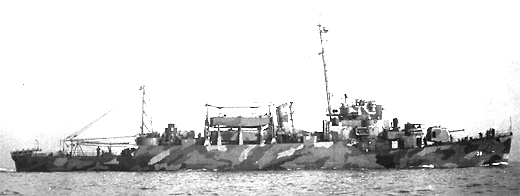
USS Barr (APD-39) in October 1944. These ships were famous for being camouflaged in various tones of army olive green and other shades obtained by mixing any readily available paint. It was largely unofficial and documentation is scarce, although bases were readily available, an extension of Measure 31 already used for the APD-1 serie. The deck was also camouflaged. The idea was to have these ships blending in the environment of small island with lush vegetation.

Camouflaged APD-37 class vessel (unknown), old author’s illustration
Specs (APD-37):
Displacement: 1725 t ST, 2114 t FL
Dimensions: 93.27 x 11.28 x 3.84 (306 x 37 x 13 in)
Machinery: 2 shaft turbines, 2 boilers, 12,000 shp, 23.6 knots
Range: Oil 347 t, 5,000 nm at 12 kts
Armament: 1-5in/38, 3×2 40 mm AA, 6x 20 mm AA, 2 DCR
Boats carried: 4 LCVPs, 162 troops
Crew: 203
LST class landing ships (1942)
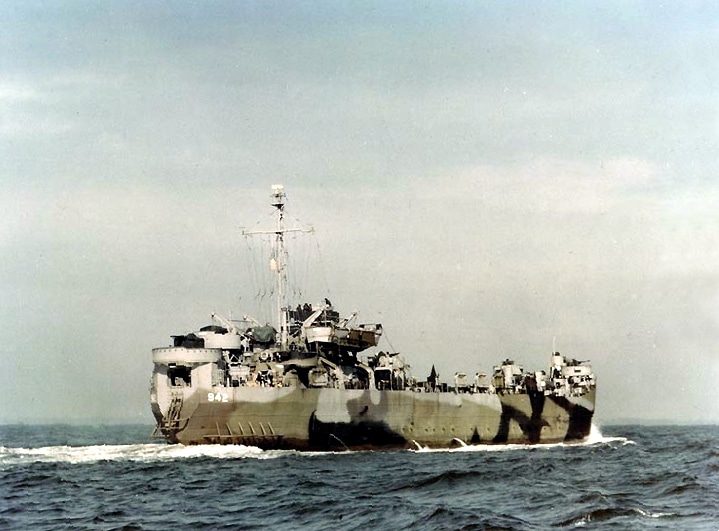
LST-942 in 1944
Probably the most famous of these amphibious ships, the LST (infamously nicknamed “Large Slow Target”) was really a solid alternative to the Assault ships, which primarily carried troops, later to be lowered in landing crafts, a long operation, sometimes dangerous. The British in 1940 however already search for a type of ship able to cross large distances by itself and land heavy equipments, includng tanks directly on the beach. Better so, through lend-lease, they asked for a ship capable of carrying tanks directly from the US Coast to UK. It was known for a time the “Atlantic Tank Carrier”.
In the end, the US response proved to be a surprisingly good vessel, versatile, adaptable and reliable, of which many still are in service in many navies today. In total 1152 were built in the USA, in a variery of yards. It was the largest true amphibious ship in service, with its flat bottom and a displacement well over 4,000 tonnes fully loaded, with 1,670 tonnes of payload. The base load asked for, was twenty 25-ton tanks, and the ship was divided between an enclosed weather deck, by the forward ramp, and an upper deck for softskin vehicles and light equipment, which could be rolled to below by using a ramp. Another requirement was to carry a LCT, but variations made it carrying a variable numbers of davits aft, so to carry up to sic LCVPs. Armament also varied but was exclusively light AA 40 and 20 mm which numbers and placement diverged. The British built their own version meanwhile. LSTs participated virtually in all amphibious operations from 1943 until the end of the war, seeing service in Korea and even in Vietnam.
A complete overview of the type was done here.
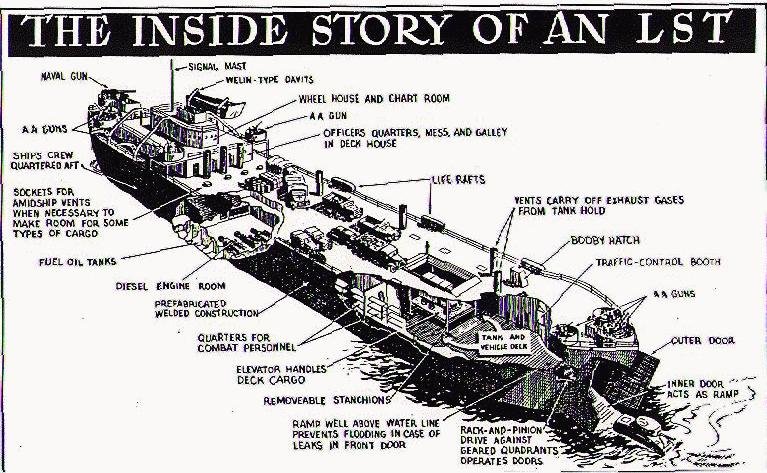
Specs (LST):
Displacement: 1625 t ST, 2366-4080 t FL
Dimensions: 99.98 oa x 15.24 x 1.19-3 m (328 x 50 x 3-9 ft)
Machinery: 2 shaft diesels, 1,800 shp, 12.1 knots
Range: 24,000 nm at 9 kts
Armament: 7x 40 mm AA, 12x 20 mm AA
Boats carried: 2-6 LCVPs, 160+ troops
Crew: 111
LSV class landing ships (1942)
USS castkill, Ozark, Osage, Saugus, Monitor, Montauk.
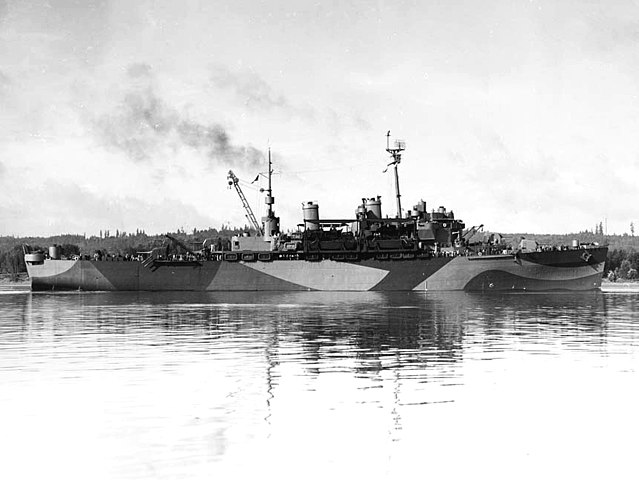
USS Ozark, 16 sept. 1944
The history of these ships is quite original, as the acronym. They came from a proposal to convert the USS Terror in construction at the time, as the first fleet mnesweeper, into a vehicle carrier for amphibious operations. Indeed, the builders of USS Terror, Philadelphia Navy Yard, alleged in 1940 that they could easil convert their ship into a vehicle carrier with more capacity than the average assault carriers of the time, based on civilian cargos, for a better speed, armament, and less displacement. The idea was seducing enough for the US admiralty to take note. In fact, a modified Terror design was ordered as a netlayer (AN), but since it was far larger than the HMS protector that was used as model, and plans were sligthly modified, having a large cargo space fully enclosed, without the STS armored deck and its stern modified to handle the nets.
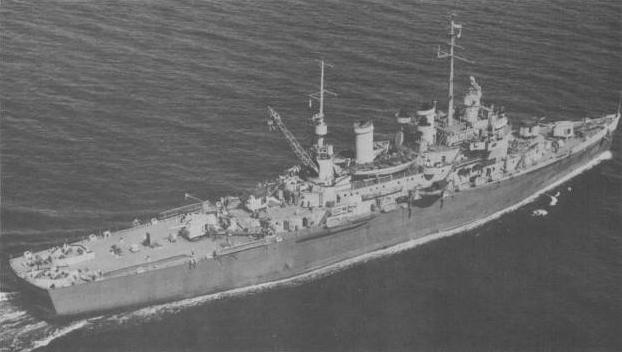
USS Terror, CM-5
In the end, four were ordered (AN-1-4) under the 1940 program, including the “repeat- terror” designated CM-6-7. In 1943 these ships were redesignated as vehicle transports, with their stern modified again to manage two ramps, and retaining most of their armament, fire control system, and extensive suprerstructures. They had the great advantage of being submerged, allowing amphibious vehicles and landing crafts to exit from the stern, fully loaded. Typical load included 44 DUKW loading 800 troops and equipments. In other cases, the former AN-1-2, 19 LVT and 29 DUKW (see the amphibious vehicles index at the end). The AN-3-4 carried 21 LVTs and 31 DUKW. They also were modified with davits to carry 14 LCVPs on deck, plus a large service crane aft.
Launched in 1942 but converted in 1943 they were recommissioned in 1944, participating in the last operations on the pacific theater: Luzon, Iwo Jima, Okinawa. In 1946 they also took part in Magic Carpet, before being laid up in 1946. They were converted afterwards to other roles, like mine countermeasure ships, discarded in the 1970s.
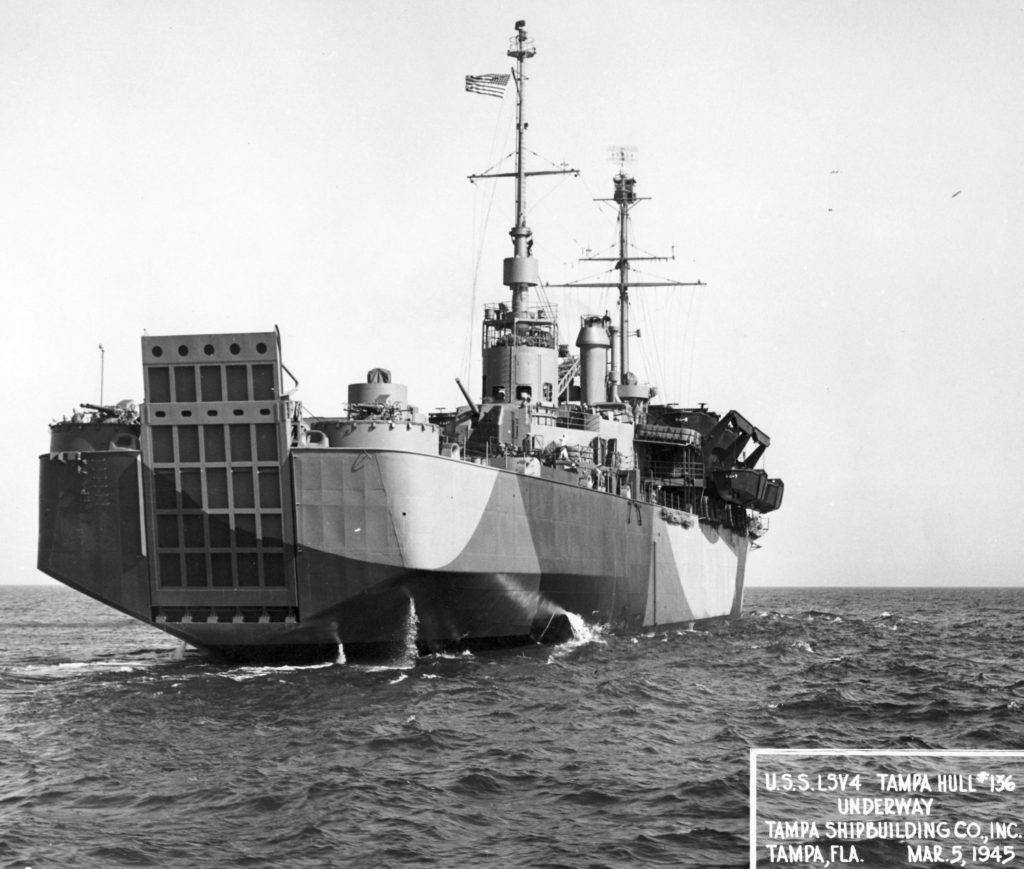
LSV-4, USS Saugus, showing its aft ramp. cdts: navsource.org
Specs (LSV-1):
Displacement: 5630-5875 t ST, 9,000 t FL
Dimensions: 135-137.84 m oa x 18.36 x 6.10 m (455 x 60 x 20 ft)
Machinery: 2 shaft geared turbines, 4 boilers, 11,000 shp, 20 knots
Armament: 2x 5-in/38, 4×2 40 mm AA, 20x 20 mm AA
Boats carried: see notes
Crew: 564
LSM class landing ships (1943)
425 ships 1943-45: LSM-1-187, 200-400, 413-500, 537-588
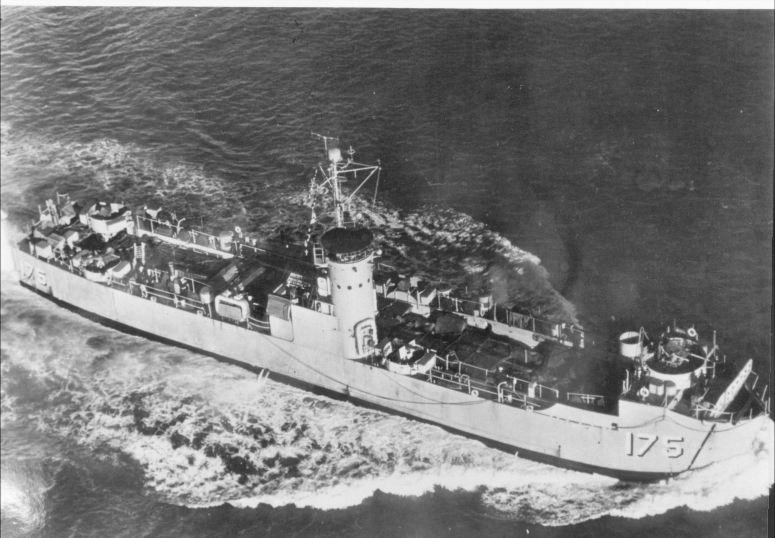
Early in 1943, BuShips started studies for an ocean-going tank lighter intermediate between the LCT and LST. But it had to be faster, to be combined with the LCI(L). It gave cluse about its displacement, three times that of an LCT6, with a cargo of 165 tonnes. The studies ported on a hull with higher freeboard and better strenght and to carry the tankers in good conditons to arrive fresh on the battlefield. BuShip memo from 28 August also states the ship should be fit for long voyages, to the limit of extreme bad weather. The open cargo bay only was compatible with non-perishable loads.
It had to have a watertight superstructure or deckhouse on either side of the central bay, for additional buoyancy and improved stability, plus a bridge for command on the left side. Rapid self-drainage and reliable pumps with manual backup were to be provided as well. The deck payload corresponded to standards seen on the LCT6 between trucks and tanks which had a quite different density. As a rsult of all this, resulted the LSM for Landing Ship, Medium.
It became the priority of the 1944-45 amphibious program and consruction started in early 1944 with 588 ordered part of which were converted as support ship with rocket launchers, called LSM(R) – see later.
Due to their late arrival, laid down in March-April 1944 for the first, completed in June, they were mostly used in the Pacific theater. The battle stars won by this class were primarily at Luzon, Iwo Jima and Okinawa. After the war, and Operation Magic Carpet in 1946, these ships were loaned, sold or mothballed for the remainder until the 1970s.
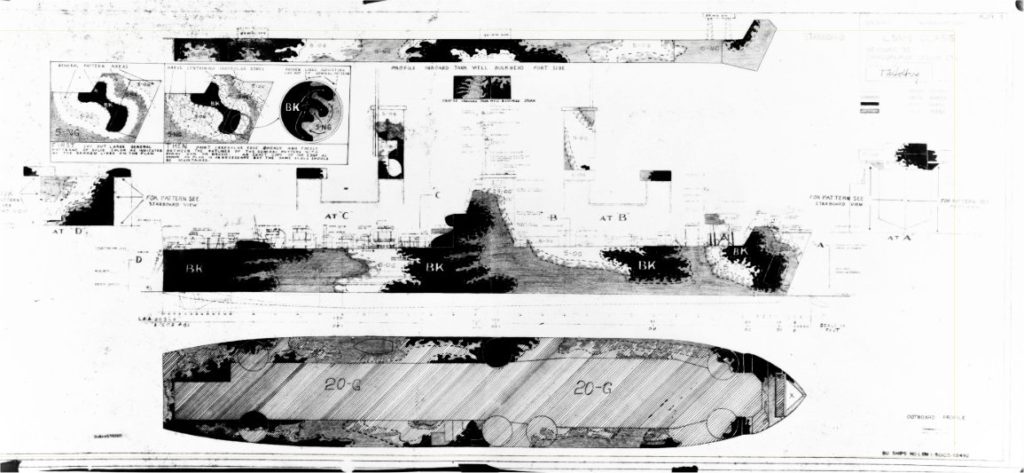
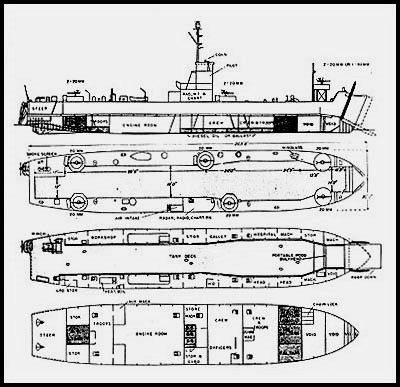
ONI camouflage pattern and ship’s plan (navsource)
Specs LSV-1:
Displacement: 720 t light, 743 t landing, 1095 t sea going FL
Dimensions: 59.89 wl, 62 m oa x 10.52 x 1.07-2.13 m (203 x 34 x 3-7 ft)
Machinery: 2 shaft diesels, 2,800 shp, 13.2 knots
Range: 4,900 nm at 12 kts
Armament: 2x 40 mm AA, 4x 20 mm AA
Boats carried: 5 Medium/3 Heavy tanks/6 LVT/9 DUKW, 48 troops
Crew: 60
LCI(L) class landing ships (1942)
LCI(L)-1 – LCI(L)-1139
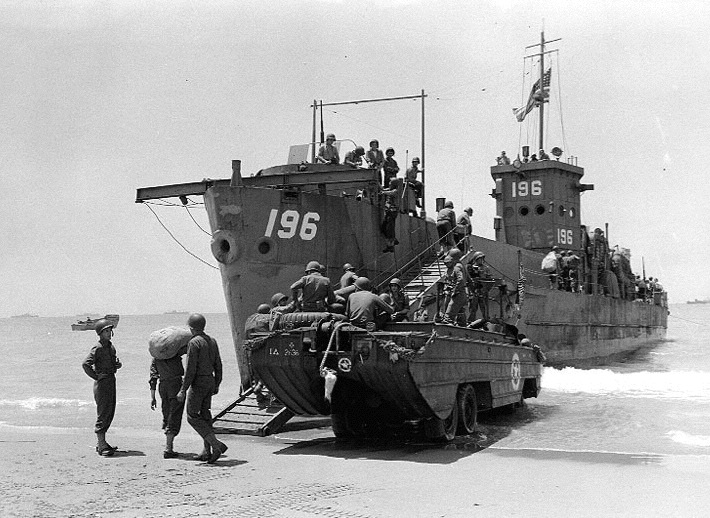
LCI(L) 196 close to a DUKW in Sicily, Operation Husky, 11 July 1943
These famous sea-going infantry-alone transport ships became also a class for many more types during WW2. 1,139 were delivered in all from late-1942 to early 1945, slightly less than the LSTs or LCTs. The acronym meant “Landing Craft Infantry(Large)” and it was at first required by the British as a fast personal carrier for commando raids and small amphibious operations. Contrary to LCV-LCVPs which were barely seaworthy and short range, these ships were designed as ocean-capable.
The US admiralty staff drafted requirements to US yards for these, published on 30 April 1942.
It was calling for:
-300 ships
-200-250 troops capacity
-20 knots and 500 nm endurance at 15 kts
-Capable of crossing the Atlantic (with extra storage)
-Able to beach, with gangways
With that, proposals for tenders were made, and the real difference between them and all other such landing ships/crafts was their use of side gangways instead of a ramp. This derived fro British practice: Troopships traditionally landed personel from side gangways to the peer. The absence of watertight front doors made the design sturdier and cheaper, allowing a greater number to be built.
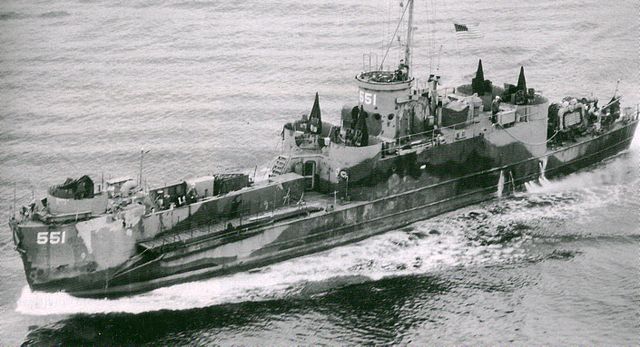
LCI(L) 551, late serie, pacific May 1945. She was transferred to the Soviet Navy on 29 July for Project Hula as DS-48, taking part in the Soviet invasion of the Kuril Islands.
The admiralty final design of the then “APY” was published in May 1942, ad one proposal was to use the existing PC hull (sub-chaser) to reuse as much components as possible, but it was rejected and the length was fixed to 153 feets (48 meters). It was stating that “the vessel is to be of such arangement that it can be adapted to the transport of packaged cargo which is susceptible of manhandling”, it was precised a max capacity of 75 tonnes. That gave some flexibility in its use. Greenlight was awarded in June 1942 and production started right away, at New York SB, Camden, USA, laid down in July, launched in September and completed in October 1942. Others were built by Bethlehem (Hingham), Federal (Newark), George Lawley (Neponset), and New Jersey SB (Barber).
Production ceased exactly two years later, the last commissioned (modified as variants), in March 1945. 30 craft were also transferred to Canada.
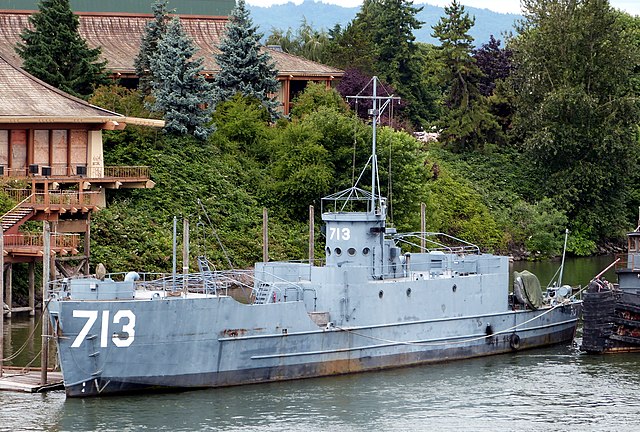
Surviving LCI(L) 713 in Portland, Oregon
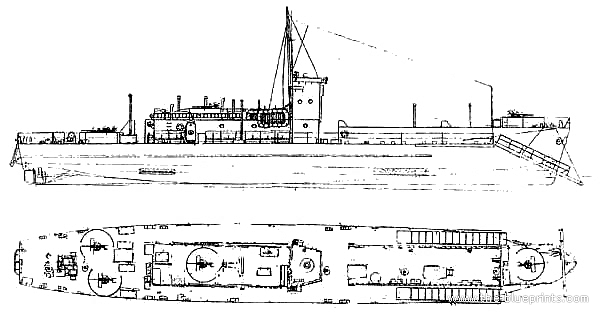
Specialized variants:
- LCI(FF)/LCI(H): 49 flotilla flagships conversions
- LCI(M)*: 42 Support variants: 3-4.2 in chemical mortars, 1x 40 mm AA
- LCI(R)**: 36 Rocket launcher version with 6x 5-in RL
- LCI(G)***: 86 support versions with 6 optional batteries and Mk1/Mk10 RLs
- LCS(L)(3): 130 support versions AA and Mk 10 RL
- AMC(U): 5 underwater object locators
*Mortar
**Rocket
***Gunboat
Specs LCI(L)1:
Low, square-cut conning tower.
Displacement: 194 t light, 387 t sea going FL
Dimensions: 46.63 wl, 48.31 m oa x 7.21 x 0.8-1.52 m (158 x 24 x 2-5 ft)
Machinery: 2 shaft diesels 2,320 shp, 15.5 knots
Range: 8,700 nm at 12 kts, diesel 120 tons
Payload: 188 troops or 75 t of cargo
Armament: 1x 40mm QF Mk VIII, 3x 20mm AA
Crew: 24
Specs LCI(L)351:
Tall, round conning tower and modified arrangements
Displacement: 209 t light, 258 t landing, 385 t sea going FL
Dimensions: 48.46 wl, 0.86-1.60 m (159 x 2ft 10 in-6 ft 3 in)
Range: 8,000 nm at 12 kts, diesel oil 110 tons
Payload: 209 troops or 75 t of cargo
Crew: 29
LSD class landing ships (1944)
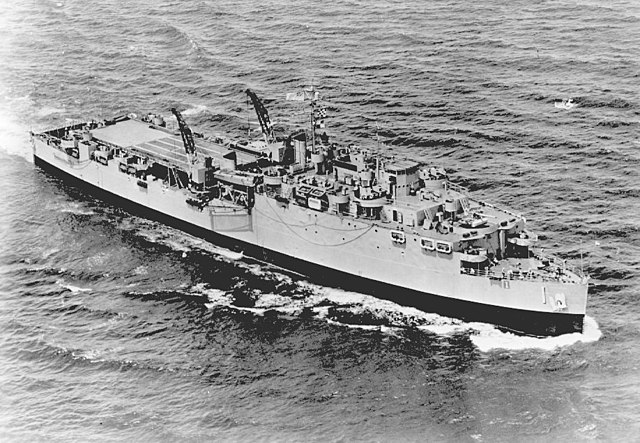
Moore yard (Oakland): LSD-1-8: USS Ashland, Belle Grove, Cartter Hall, Epping Forest, Gunston Hall, Lindenwald, Oak Hill, White Marsh
Newport News: LSD-13-19: USS Casa Grande, Rushmore, Shadwell, Cabildo, Catamount, Colonial, Comstock
Boston NyD: LSD-20,21,26,27: USS Donner, Fort Mandan, Tortuga, Whetstsone
Gulf SB: LSD-22-24: USS Fort Marion, Fort Snelling, Point Defiance
Philadelphia NyD: LSD-25 San Marcos
Design development
The last and arguably most promising of the specialized landing vessels armada of WW2 was certainly the “Landing Ship, Dock”. It was something we would recoignise today, since all contemporary assault ships are modelled after this class, minus the adjunction of a flying deck and helicopters. It was the idea of a self-propelled drydock, which would have the advantage of just releasing pre-loaded landing crafts after filling its ballasts, in a short notice. This was so far the fastest and safest way possible, but there were many issues to deal with until the design was ready.
Just like the LST and LCT, it came in 1942 from a British specification of a “TLC carrier”, after its specifications evolved from a “truck transport”.
The emphasis on the original design was to just be able to carry as many vehicle as possible, on several levels, as well as carrying large beaching crafts to land them as quickly as possible. A flooding deck aft and capacity for at least two British standard LCTs were precised later.
The latter was to be able also to carry three US-standard LCT(S) in alternative, fully loaded with three medium tanks each. Another option precised a carrying capacity of fourteen LCM(3) each carrying a Medium Tank. A key part of the design was to have detachable decks wit loading ramps on at least two levels, ideally three. A High speed of 17 knots was also part of the requrirement.
Evetually, the Propulsion chosen consisted in to shafts connected to two Skinner Uni-Flow reciprocating engines, fed by two oil-fired Babcock & Wilcox boilers for the planned speed, 17 knots (31 km/h; 20 mph). Her Endurance was about 8,000 nmi (15,000 km; 9,200 mi) at 15 knots (28 km/h; 17 mph). For armament, she was armed by a single 5 in/38 cal. DP gun a the bow, and two single 40 mm quad AA guns and two twin 40 mm AA guns placed on the side structures as well as sixteen single 20 mm AA guns.
Construction and service
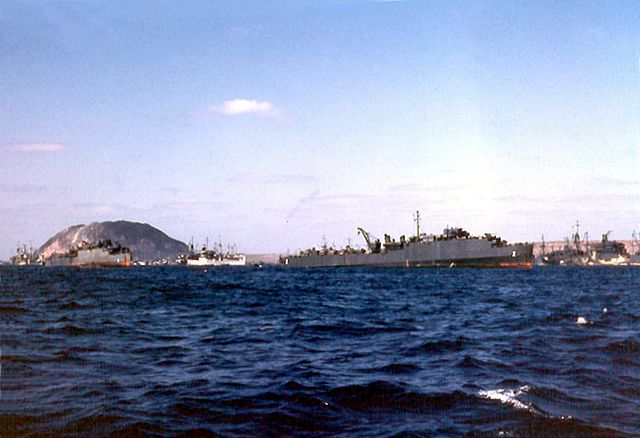
USS Ashland and Bell Grove at Iwo Jima, 1945, both in dark navy blue
There were two classes in reality: The Ashland class (LSD-1-8) and Casa Grande class (LSD-13-27). The latter were similar but with a more powerful propulsion, around 7,000 or 9,000 bhp. They could carry three LCT Mark V/VI or two LCT Mark III/IV or 14 LCM Mark III or 41 × LVTs or 47 DUKWs.
These ships were commissioned in 1943-44, 1945-46 for the second serie, and seeing the late Pacific campaign, the Philippines, Iwo Jima and Okinawa. But their service did not ceased there. They served also in Korea and Vietnam, being discarded in 1969-70.
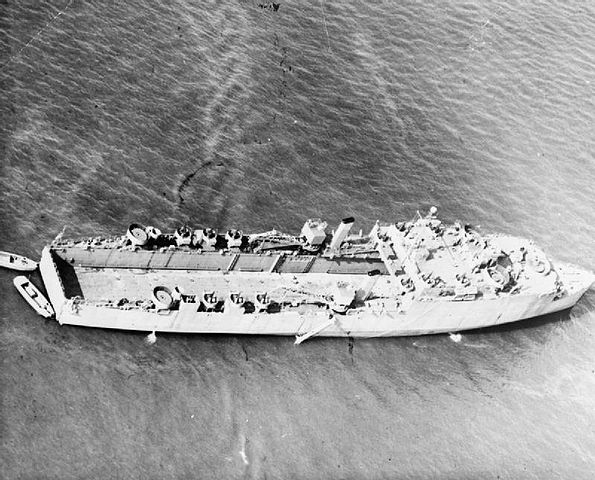
HMS Highway, showing the open aft bay
Four ships also served in the Royal Navy, Eastway (F130, to Greece 1953; scrapped, 1972), HMS Highway (F141, sold 1948), HMS Northway (F142 Sold, 1948, scrapped, 1975), HMS Oceanway (F143, Transferred to Greece, 1947, France 1952; sunk as target 1970 ). The British initially ordered seven of these numbered LSD-9-15. However only four were delivered (9-12) while 13-15 returned in the US Navy, ordering another twelve, to built ten, the rest cancelled. This explains the gap in number for LSD-10, 11, 12 and 13, the British units.

Profile Scheme of the class in 1943 (navypedia)
Specs LSD:
Displacement: 4,032 tons, 7,930 tons tons FL
Dimensions: 139.52 x 22 x 4.93 m (458 x 72 x 15-16 ft)
Propulsion: 2 shafts Rec. engines, 2 B&W boilers, 17 kts
Range: 8,000 nm at 15 kts, diesel oil 110 tons
Payload: 218 troops, 22 officers, see notes
Crew: 267 + 23
Armament: 5in, 4×40 mm, 16x 20mm AA
US Navy landing Crafts
First things first: A landing Craft is different from a landing ship in the sense the second can carry the first, not the reverse. Basically the same as the distinction between a boat and ship. By production statistics alone, landing ships produced during WW2 equalled 2066 landing ships all combined, versus 44,000 so a ratio of 22, consistent with the number of landing crafts carried.
LCT(5/6) class landing crafts (1941)
LCT(5): 500 delivered. LCT(6): 965 delivered.
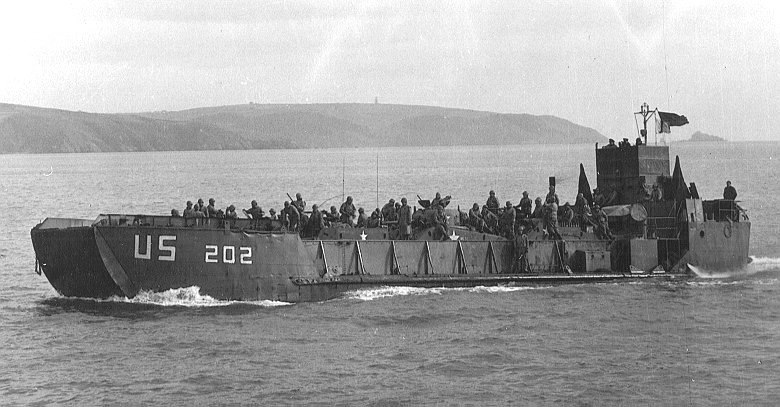
LCT-202, LCT(5) class landing craft.
As most other USN landing ships and crafts, the LCT came from a British idea. In fact the latter started working on the LCT(1) already in 1940. They had completed the first 30 LCT Mark 1, built at Hawthorn Leslie in from November 1940. It was not very fast at 8 knots, displacing 372 long tons (378 t) for 152 ft long and 29 ft wide, propelled by two 350 hp (261 kW) Hall-Scott petrol engine and possessed some armour. These were the essential traits asked for the next iteration, the LCT Mark 2. 73 were completed in 1941, much faster with their three Paxman diesel or Napier Lion petrol engines. Only 79 were delivered, and they were succeeded by the Mark 3 the same year, longer but slower, and produced to an extent of 235 ships. US Troops made use of some during Operation Torch in November 1942. The Mark 4 was wider and heavier, displacing 350 tons, and carrying nine M4 Sherman or six Churchill tanks. 865 were manufactured until the end of 1942, but British industry was reaching its limits there. In addition, flaws were found in its desig, apparent during the raid of Dieppe in fall 1942.
That’s why an agreement was found with the US to deliver 470 US-Built Mark 5 or in USN ordnance, LCT(6), from 1942 to 1944.
Production of a smaller vessel, more comparable to the Mark 1 but even smaller to be transported more easily. In that regard, it displaced 286 short tons (259 t) (landing), compared to the 640 long tons (650 t) Mark 3. The latter were used in relatively restricted maritime areas, like the channel and bay of biscaye, so transport was not a priority, if practical.
These were the largest of all US Amphibuous crafts, shipborne. They could be carried by a LST on deck and launched broadside empty, to make for the lack of range. This was used for its lack of autonomy. More commonly it was transported in sections, 50 tons less each, buoyant and bolted on.
It was specified by the British as an US-built Thornycroft design 100 feets tank lighter, still able to carry medium and heavy tanks. The November 1941 admiralty staff requirements called for a capacity of six 10-ton trucks, three heavy tanks (50 tons) or six medium (27 tons Lee, later Sherman) including two abreast. They were initially planned as point-to-point lighters for the restricted waters of the Mediterranean or Channel. They were planned in fact for the short channel crossing, in planification of future landings in Europe. They were not expected to cross the Atlantic, seaworthiness in that regards was limited. That’s when the LSDs comes in handy to carry them fully loaded, coast to coast.
The USN BuShips managed to deliver their own design based on these requirements withing a month, so in December 1941. Production was setup when the US went at war, and in British service it was designated LCT Mark 5, LCT(5) in USN service. Most were delivered via lend-lease, and the Free Polish Navy also obtained some, used later at D-Day.
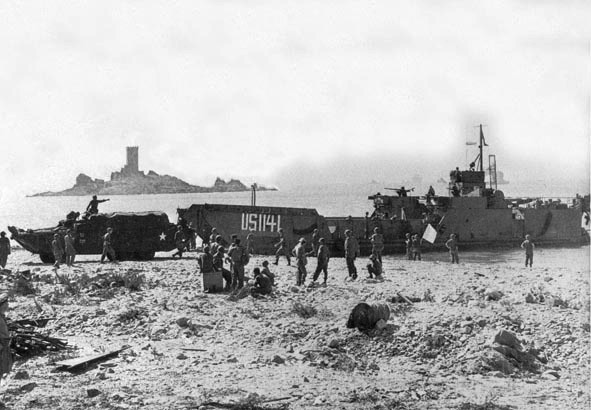
LCT(6) at Operation Dragoon, landing at St Raphael
The LCT-6 was basically an improved version, made for operating as a clauseway between an LST and the beach. It had detachable stern plates with a leap beneath it to allow the LST ramp to engage. The LCT(6) were manufactured between June 1942 and December 1944 for a grand total of both combined, of 1465 LCTs according to the identification numbers. postwar suvivors were redesignated LCU and relatively similar classes were derived during the cold war from these. For designation, LCT(7) became the LSM while the LCT mark 8 was unrelated and British only. Sox ships were also converted into underwater object locators AMC(U)1-6.
Specs LCT(5):
Displacement: 283 tons landing
Dimensions: 32 wl/34.80 x 9.96 x 0.86-1.22m (114x 33 x 2-4 ft)
Propulsion: 3 shafts diesels 675 bhp, 8 kts
Range: 1,200 nm at 7 kts, diesel oil 6? tons
Payload: 4 md/3 heavy tanks, 150 t cargo, approx. 120 troops
Crew: 11
Armament: 2x 20mm AA
Specs LCT(6):
Displacement: 309 tons landing
Dimensions: 36.30 x 9.96 x 1.09-1.27m (119x 33 x 3-4 ft)
Crew: 13
Higgins LCP(L) class landing craft (1941)
About Higgins
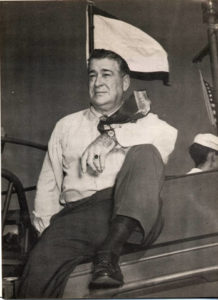 Andrew Higgins was in the lumber business in New Orleans until her moved gradually into boat building, a growing and ultimately only one after he filled a bancrupcy note for his lumber transport company in 1930. His wooden flat-bottom fast boats were marketed to trappers (like the 1926 model) and oil-drillers, possibly also underhand to smugglers, in particular during the prohibition. However the 1929 crisis and possibly the end of the prohibition left his company into grave financial difficulties. Ultimately via contact her earned the interest of the U.S. Navy. A providential one at the end of the 1930s. Indeed, the USMC looked for new ways of safely transport and beach personal in amphibious operations.
Andrew Higgins was in the lumber business in New Orleans until her moved gradually into boat building, a growing and ultimately only one after he filled a bancrupcy note for his lumber transport company in 1930. His wooden flat-bottom fast boats were marketed to trappers (like the 1926 model) and oil-drillers, possibly also underhand to smugglers, in particular during the prohibition. However the 1929 crisis and possibly the end of the prohibition left his company into grave financial difficulties. Ultimately via contact her earned the interest of the U.S. Navy. A providential one at the end of the 1930s. Indeed, the USMC looked for new ways of safely transport and beach personal in amphibious operations.
The Eureka boat
Higgins Eureka boat was designed to work in the swamps and marshes of south Louisiana. The shallow-draft boat could operate in only 18 inches of water, running through vegetation and over logs and debris without fouling its propeller. It could also run right up on shore and extract itself without damage. As part of his sales demonstrations, Higgins often had the boats run up on the Lake Ponchartrain seawall. Its construction used the “headlog” – a solid block of pine at the bow – and strongest part of the boat, enabling it to run at full speed over floating obstacles, sandbars, and right up on to the beach without damaging the hull.
A deep vee hull forward led to a reverse-curve section amidships and two flat planing sections aft, flanking a semi-tunnel that protected the propeller and shaft. Aerated water flowing under the forefoot of the boat created less friction when the boat was moving and allowed for faster speeds and maneuverability. Because of the reverse curve, objects in the water would be pushed away from the boat at a point between the bow and amidships (including the aerated water—only solid water reached the propeller). This allowed continuous high-speed running and cut down on damage to the propeller, as floating objects seldom came near it. The flat sections aft, on either side of the shaft tunnel, actually had a catamaran/planing effect which added to the hull speed.
All of these features contributed to the boat’s successful adaptation as a landing craft. The Navy named it the LCPL, or Landing Craft, Personnel, Large. It joined Higgins’ LCVP, LCM and PT Boat as mainstays of the fighting Navy in World War II.
The Navy became growingly frustrated by the lack of interest from the Navy’s Bureau of Construction and Repair. Their rare proposals were almost always off-the-mark. Requirements were enlarged to the private sector and Higgins soon proposed his own boat. Later Higgins would also take on the construction of many MTBs, also vital in the Pacific. But that’s a story for another day. His company will deliver successively the LCP(L), LCP(R) and finally the semi-armoured LCVP, improving the concept of landing craft until its pinnacle in 1944.
The LCP(L)
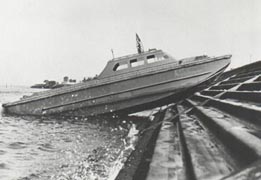 Higgins “Eureka boat” was tested in 1938 both by the Navy (to carry them) and US Marine Corps, and its surpassed performance of the Navy-designed boat. It was tested fleet landing exercises in February 1939. The USMC found it satisfactory but the navy expressed its main drawback, as the equipment had to be unloaded manually, which was long and complex, and men disembarked over the sides, exposing them to fire. Still, since it was the best on offer, the Navy approved a contract and production run, called Landing Craft, Personnel (Large), or LCP(L). it was notably caracterized by two machine gun positions at the bow which camed in handy for cover fire on the beach, although leaving the personal largely unprotected. The LCP(L), often simply called “Higgins boat” by the allies, was first supplied to the British from October 1940, where they called it the “R-boat”, finding it well suited for their commando raids.
Higgins “Eureka boat” was tested in 1938 both by the Navy (to carry them) and US Marine Corps, and its surpassed performance of the Navy-designed boat. It was tested fleet landing exercises in February 1939. The USMC found it satisfactory but the navy expressed its main drawback, as the equipment had to be unloaded manually, which was long and complex, and men disembarked over the sides, exposing them to fire. Still, since it was the best on offer, the Navy approved a contract and production run, called Landing Craft, Personnel (Large), or LCP(L). it was notably caracterized by two machine gun positions at the bow which camed in handy for cover fire on the beach, although leaving the personal largely unprotected. The LCP(L), often simply called “Higgins boat” by the allies, was first supplied to the British from October 1940, where they called it the “R-boat”, finding it well suited for their commando raids.
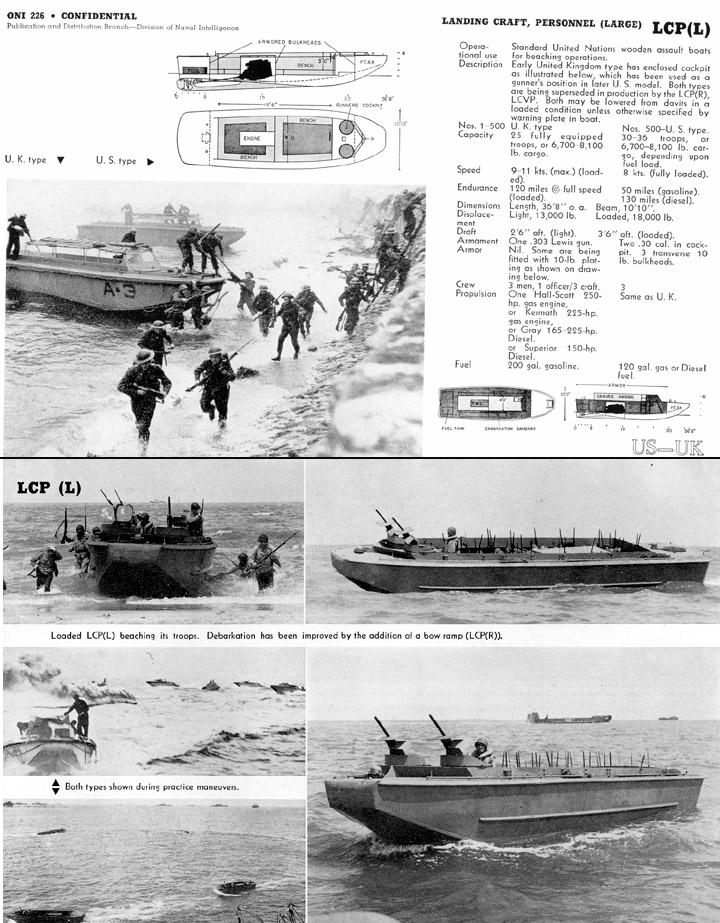
ONI plate of the LCP(L) from the ONI 225 booklet (see the sources)
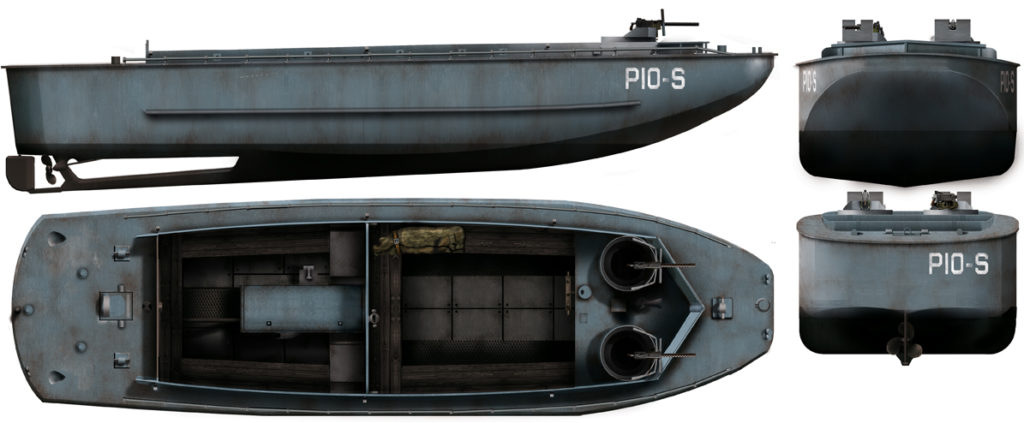
Author’s rendition of the LCP(L) used by the USMC
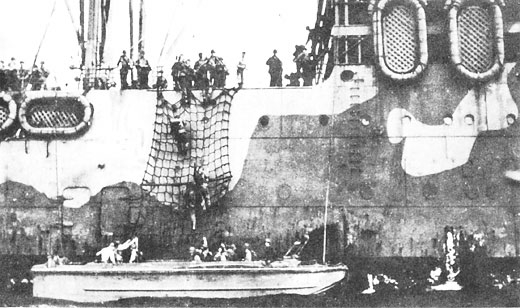
US Marines accessing a LCP(L) from a rope ladder, a common sight until the end of the war, Fiji invasion 6 July 1942.
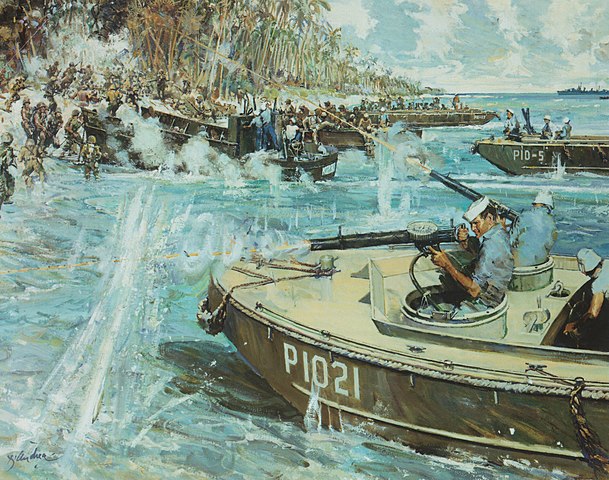
Veteran’s painting of the evacuation of Matanikau showing a LCP(L) in action with sailors firing Lewis MGs on the foreground.
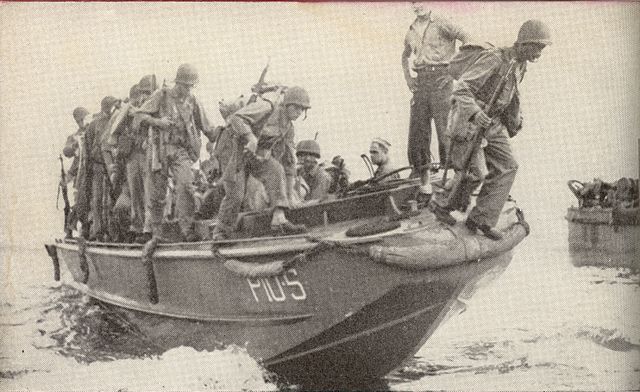
Reinforcements arrived at Guadalcana from LCP(L)s
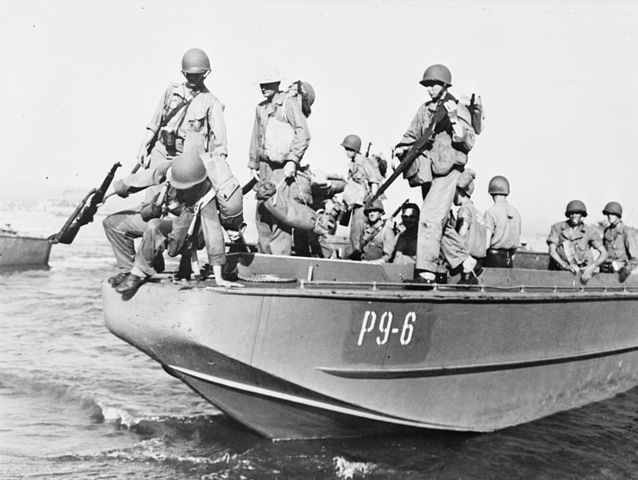
LCP(L) from USS Zeilin, training 1942
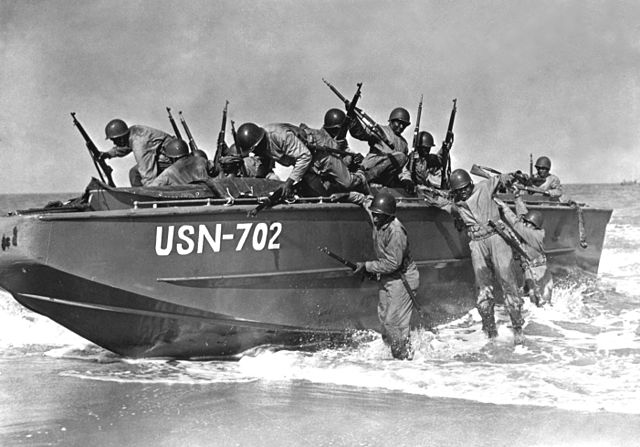
LCP training at Camp Bradford
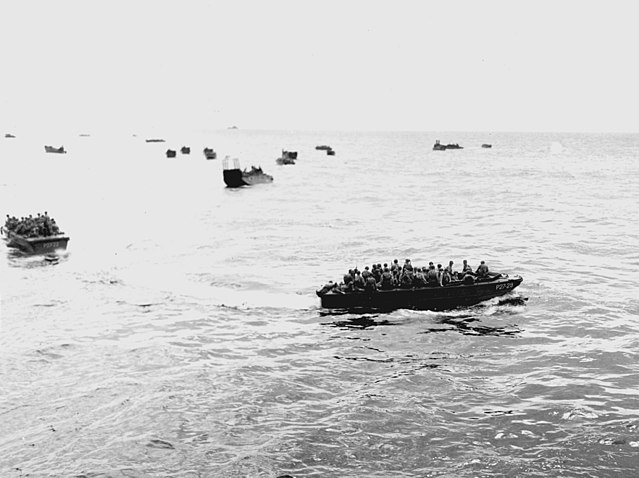
LCP(L) from USS Hunter Ligget at Guadalcana, fall 1942
Higgins LCP(R) class landing crafts (1941)
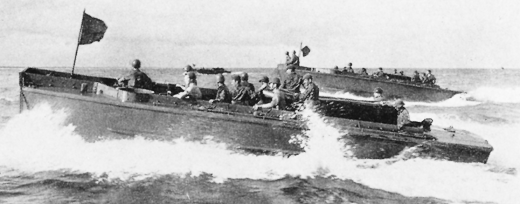
Development of the LCP(R) 1941
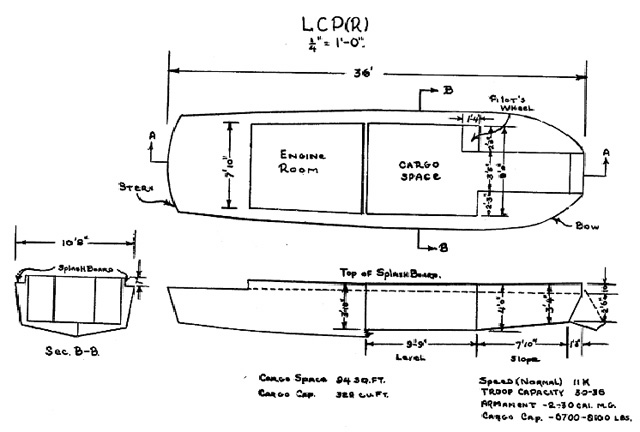
US Intel knew however the Japanese had a better “product” on hand already: They had been using since a while already ramp-bowed landing boats, notably their Daihatsu-class model in the 1930s second Sino-Japanese War. The Navy and Marine Corps observed them already in 1937 at the Battle of Shanghai. Victor H. Krulak saw them first hand and went to show Andrew Higgins a picture of them in April 1941 in Quantico, suggesting he developed a ramped version of his initial design. Higgins briefed his designers on adapting this idea and they developed three crafts without any Navy order on a 36ft LCP(L), on private funds. First tests were performed internally on 21 May on Lake Pontchartrain. The new craft eliminated the danger of disembarking over the sides and for that, featured a bow ramp, proving to be seaworthy enough for short bodies if water. It was beached and could disengage easily enough. The ramp was lowered and lifted without problems.
Design
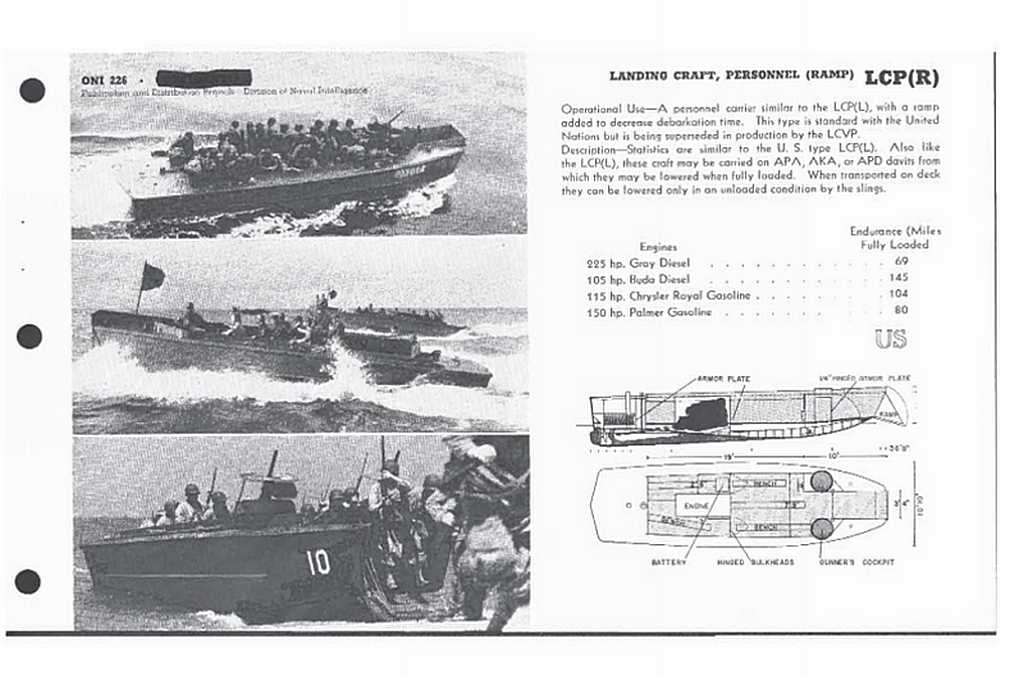
The LCP(R) was of wooden construction. It had a rugged wooden frame, light plywood sides, but a double plank bottom. It used a thick pine block outer layer, and plywood inside. They wee mosty powered by a Gray Marine 225hp diesel engine also used on the LCP(L). In some case however, less powerful gasoline engines were fitted for practicality. Its capacity was 36 up to 39 fully equipped combat troops. It was alternative to a payload of 8,000lb (), or a light vehicle like the Jeep or Dodge WC. Despite being made in wood, it still could be lowered, fully loaded, on davits, saving considerable time and making the landing safer.
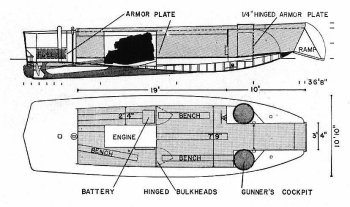
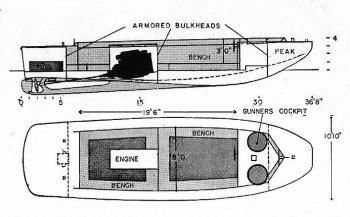
Comparison between the LCP(L) and LCP(R).
Production and service
On May 26, 1941, Cdr. Ross Daggett (BuShip) and Major Ernest Linsert of the Marine Equipment Board were invited to Higgins test area to see the three craft in action. They performed off-loading a truck, embarking and disembarking 36 Higgins employees as mock soldiers. The Navy was impressed and found a denomination for them, Landing Craft Personnel (Ramp) or LCP(R). Aftr passing all its official acceptance tests in June 1941, it soon entered service and production was ramped up at Higgins facilities, up to 2,572 being built until the Navy preferred the armoured LCVP.
These LCP(R) were largely used by the USN, seeing first use in North Africa and Guadalcanal in late 1942, and in 1943 in Sicily, and Tarawa and in Salerno in 1944. However by June they had been replaced by the improved LCVP and declared limited standard. The LCP(R)’s wooden construction however meant it could be badly damaged by beach obstacles, and not immune to enemy fire and shrapnel. It led logically to the next and last step, the composite built and armoured LCVP, of which over 20,000 were built until 1945.
Specifications LCP(R)
Length: 35ft 11.75in (11.18)
Width: 10ft 9.5in (3.30)
Draft: Light 2ft 6in/ Loaded: 3ft 6in (1.07)
Max. weight: 16,000lb/Loaded 24,100lb (12 tons)
Crew: 3
Engine: Gray Marine 64HN9 six-cyl. diesel 225hp
Armament: Two .30in machine guns (alternatives)
LCV and LCVP (1942)
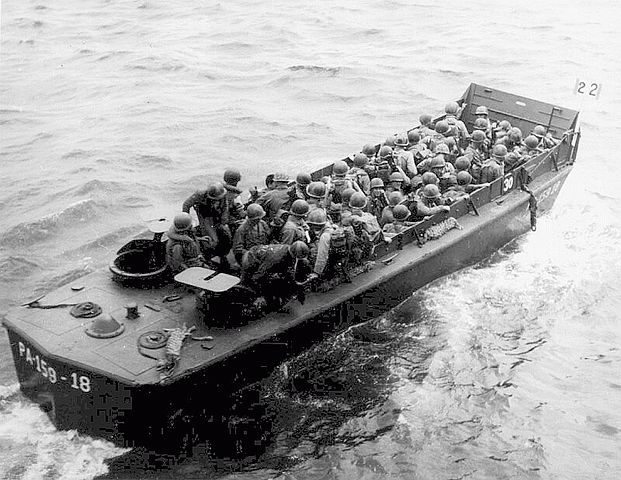
LCVP-118 in Okinawa
Development of the LCV/P
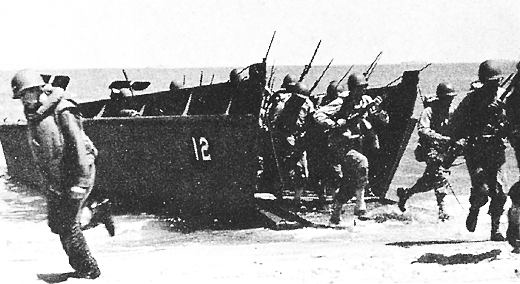
LCVP in training
The LCP(R) was designated LCVP for Landing Craft Vehicle, Personnel, mirroring the fact it was large enough to carry a jeep or lorry and troops at the same time. The LCV was the vehicle-oncly carrier denomination, while the most common LCVP carried both vehicles and personal. The latter was most commonly used and they shared the same basis anyway.
The LCVP as designed was about 36 ft (11 m) long, 11 ft (3.4 m) wide, still small but already way larger than the previous LCPs. It was still powered by a diesel, the same Gray Marine 225-bhp, but some improvments in seaworthiness and the engine itself managed to give the boat a 12 knots speed on calm weather. On choppy seas, it would sway violently because of its flat prow, causing seasickness. It was of composite for the sides and rear (plywood) but the prow was armored by a few mm to offer minimal protection from enemy fire. This saved steel. At least the ramps was way larger than on the LCP(R) as its main bay, allowing to carry a jeep.
Normal capacity was calculated around a platoon, 36 men or in alternative a jeep and a 12 me (squad), or 8,000 lb (3.6 t) of cargo. Like the former vessels it had a shallow draft (3 feet aft, 2 feet, 2 inches fwd) to beach run but still reserve since its propeller was in a semi-tunnel aft, protecting the propeller. The steel ramp had a quick release mechanism. A complete cycle between beaching, unloading and be back to a ship at sea took less than three minutes in the best conditions. Apart armor, the LVCP could no pass reefs or too shallow water, triggering the deveopment of LVTs and their larger adoption. They will prove instrumental to assault pacific lagoons surrounded by extensive reef barriers while LCVPs operated on the ocean-side beaches in general. In all, Higgins manufactured 23,358 of these, until the end of 1945.
The LCV/LCVP in action
General Dwight D. Eisenhower later declared the Higgins boat was crucial to the Allied victory on the European Western Front: “Andrew Higgins is the man who won the war for us. If Higgins had not designed and built those LCVPs, we never could have landed over an open beach. The whole strategy of the war would have been different.”
The Higgins boat saw its first use in Operation Torch in North Africa, the Allied invasion of Sicily, Operation Shingle and Operation Avalanche. Its most massive use was in Operation Overlord and Operation Dragoon, and close to 1945 the Allied Crossing of the Rhine. It saw also a wide use in the Pacific Theatre at the Battle of Guadalcanal, Tarawa, the Philippines, Iwo Jima and Okinawa. But it did not stopped there. Surplus LCVPs were alsi used by the French, modified with a roof and a 20 mm oerlikon cannon, used as “Dinassauts” during the First Indochina War in the Mekong (and unmodified ones). They also seen use in Korea, notably at Inchon. Many survived in the civilian market, despite their partly wooden hull, for many years.
Specs LCVP:
Displacement: 8 tons FL
Dimensions: 36 x 10ft 6in x 2fr 2in m (10.97 x 3.20 x 0.66/0.91 m)
Propulsion: 2 shafts diesels 250 bhp, 9 kts
Range: 102 nm at 9 kts
Payload: 36-39 troops, 1 light vehicle, see notes
Crew: 2
Armament: 2x 0.3 in MG
LCM(3) class landing crafts (1941)
8,631 vessels built by Higgins Industries.
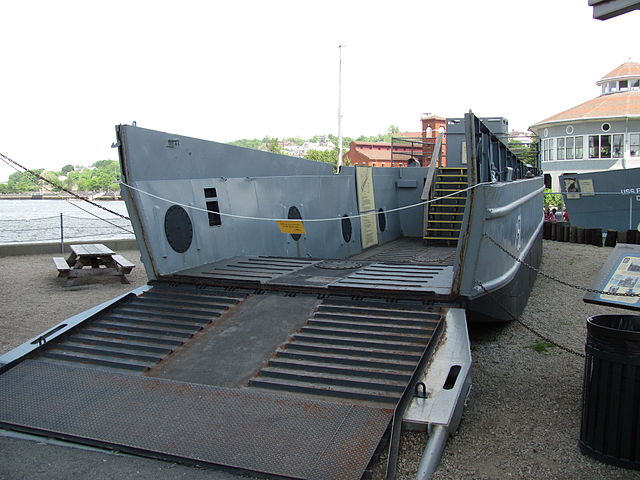
Higgins LCM-3 at Battleship Cove
Landing Ship, Mechanized (Mark 3)
In December 1941, the admiralty decided every landing should be covered by a medium, rather than a light tank. A 50 feet design was ordered.
There were two designs: The Bureau of Ship’s one was capable of carrying 120,000 lb (54,000 kg) of cargo. The private Higgins one was in appearance very similar to Higgin’s LCVP but with a 10-foot (3.0 m) wide load area (front) plus a small armoured (1/4-inch) wheelhouse aft, close to the engine room. In appearance the ended very similar to the LCVP but with slighlty more side buoyancy. It was still partially armoured, with a front steel ramp. Of course the ramp was large enough to allow a M4 Sherman to pass, with grooves along it and the bay to hold the tank in place, brakes on. It was not necessary to secure it. Large an wide, it was slow, but handle the sea better than the LCVP. It was also better armed, with heavy machine guns, placed aft of the loading bay under masks. In all, 8631 were built from late 1942 to 1945 and they were the largest possible ships carried on heavy-duty davits from transport ships;
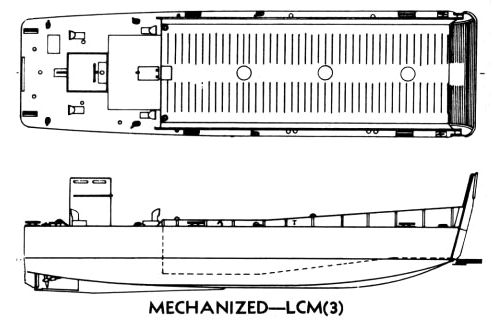
Specs LCM(3)
Displacement: 52 tons (loaded); 23 tons (empty)
Length: 50 feet (15 m)
Beam: 14 feet (4.3 m)
Draft: 3 feet (0.91 m) (forward); 4 feet (1.2 m) (aft)
Powerplant: 2x Detroit 6V-71 diesel 360 hp
Speed: 8 knots (9.2 mph) (loaded); 11 knots (13 mph) (empty)
Armament: two .50-cal M2 Browning HMG
Crew: 4
Capacity: 30-ton medium tank/60 troops/60,000 lb (27,000 kg) cargo
LCM(6) class landing crafts (1943)
2,513 built by Higgins industries
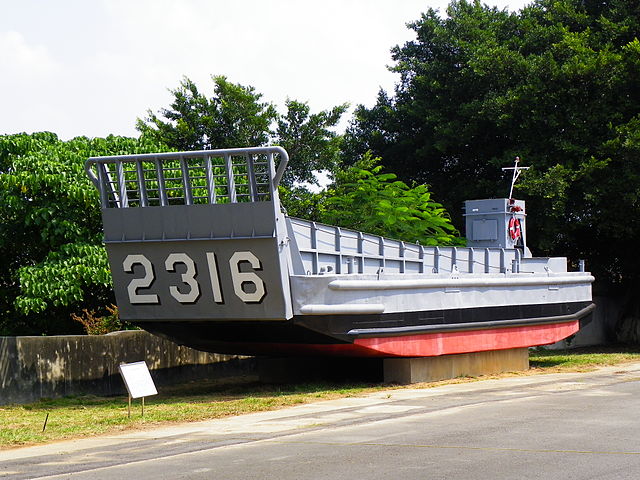
Basically this was an LCM (3) extended by 6 feet (1.8 m) amidships for a longer bay. It was redesigned to carry more troops in addition to the 30 tons Sherman Tank, and needed to be longer as a result, with a longer armoured ramp as well and reworked hull shape for better buoyancy, but with no changes in beam or daught. It was a completely different beast altogether, and that included superstructure, dimensions and displacement, and armament. Like the precious LCM(3) they could take place on the deck of an LST, but carried in modular sections, assembled on site. It was way too heavy to be supported by ships davits, but could fit side inside the LSV, side by side as the width was the same.
Many ended during the 1960s as armoured troop carriers (ATCs or “Tangos”) for the Mobile Riverine Force in Vietnam or “Monitors” with 105mm guns and “Zippos” with flamethrowers, “Charlie” command variants. See the Vietnam War Naval Warfare for more.
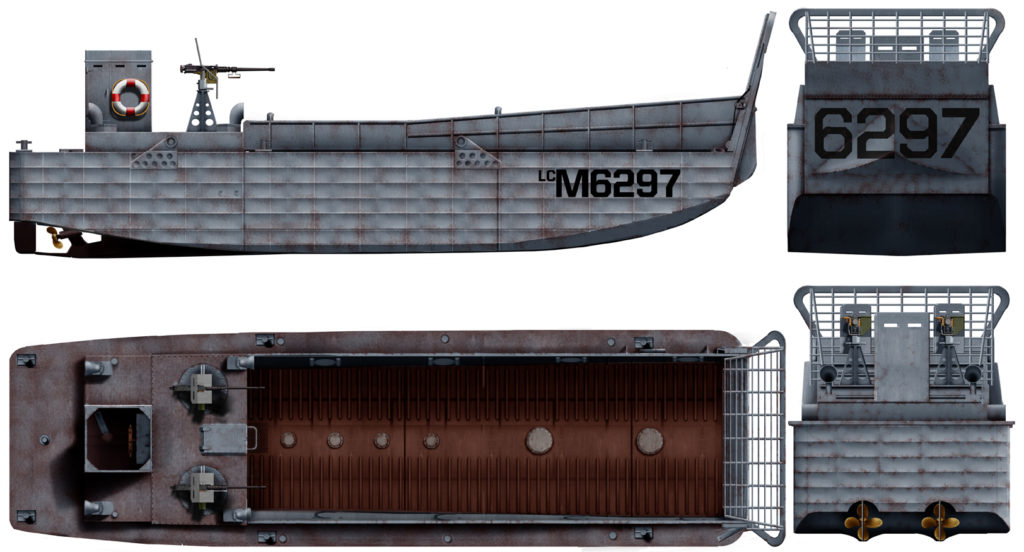
Author’s illustration of the LCM(6)
Specs LCM(3)
Displacement: 64 tons (loaded)
Length: 56.2 feet (17.1 m)
Powerplant: 2x Detroit 6V-71 diesel/8V-71 diesel engines- 360/460 hp
Speed: 9 knots (10.3 mph, 16.6 kph)
Range: 130 miles (240 km) at 9 knots (17 km/h)
Armament: two .50-cal M2 Browning HMG
Crew: 5
Capacity: 30-ton medium tank/80 troops, 34 tons cargo
US Navy Support Ships/Crafts
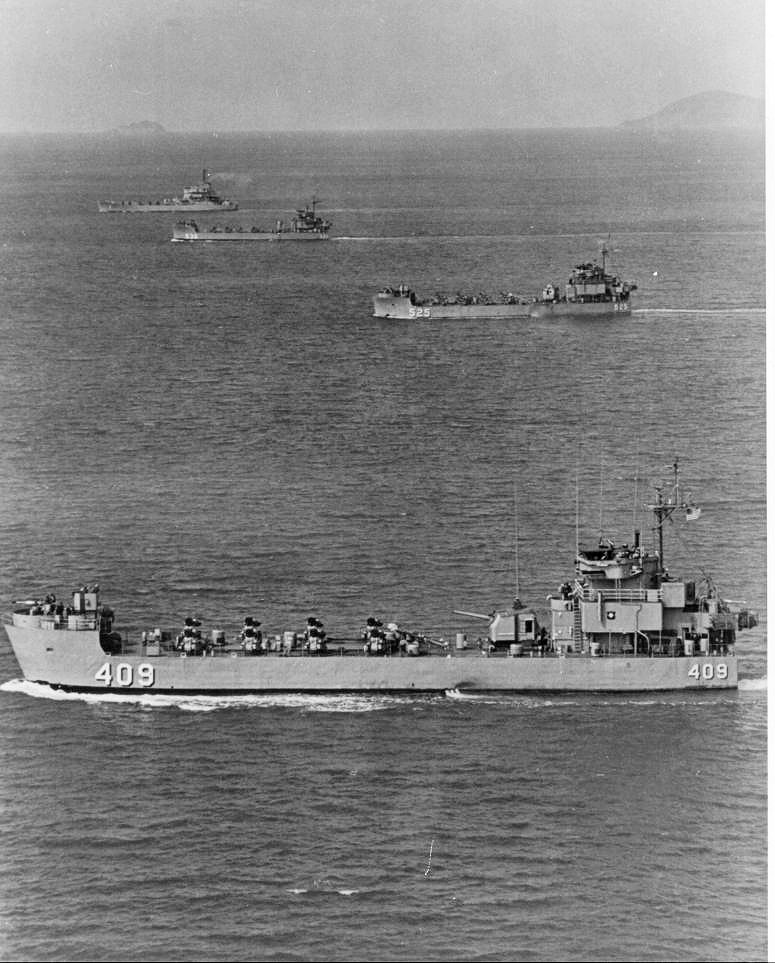
USS Clarion, River, Carronade, White River, St. Francis off Dan Nag, Vietnam, 1967. The ultimate LSM(R) were probably the best, most specialized amphibious support ships of WW2, with a spectacular firepower. They also served in Korea and Vietnam.
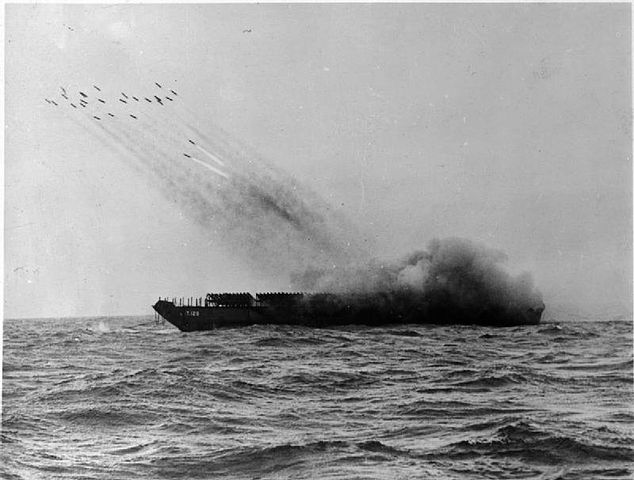
LCT LC(R) T125 firing
LSM(R) class fire support ships (1943)
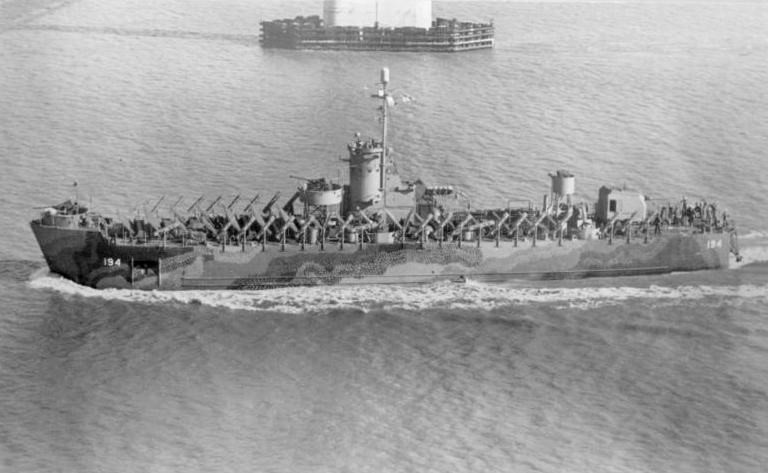
USS LSM-194 of the second sub-group
The first were LSM-188-199, converted as support ships armed with rockets (hence the (R)).
They had a single enclosed 5-in gun aft, as well as four 4.2 in mortars plus 85-105 rockets in front. They were armed with a single 5″/38 caliber gun, two 40 mm AA guns and three 20 mm AA guns
plus 85 Mk. 51 automatic rocket launchers.
The last four LSM(R) 196-199 were rearmed with 75 four 4-rail Mk. 36 rocket launchers, 30 6-rail Mk. 30 rocket launchers and 85 Mk. 51 automatic rocket launcher plus a single 5″/38 caliber gun and two 40 mm AA guns.
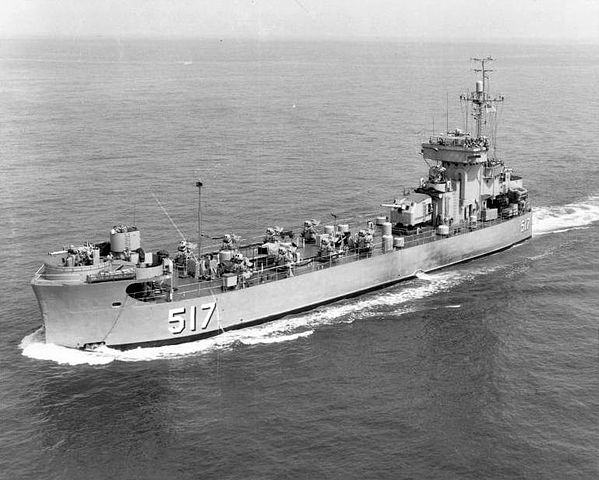
USS Pee Dee River, LSM(R)-517 of the 501 group.
48 more ships were later redesigned LSM(R)401-412 and 501-536 with modified superstructures. The LSM(R)-188 was very close to the original LSM, while the LSM(R) class had a new superstructure built right aft, the gun moved forward and ten automatic rocket launchers were placed along the hull, five on each side, instead of simple rails for easy reload, plus two 40 mm Bofors. Total:
One 5″/38 caliber, two 40 mm AA guns, four 20 mm AA guns, four 4.2 in (110 mm) mortars up to ten continuous loading 5-inch (130 mm) Ship-to-Shore rocket launchers.
The second serie starting with LSM(R)501 was the most heavily armed, with the same single 5″/38 caliber gun, four 40 mm AA guns, eight 20 mm AA guns, four 4.2 in (110 mm) mortars and twenty continuous loading 5-inch (130 mm) Ship-to-Shore rocket launchers.
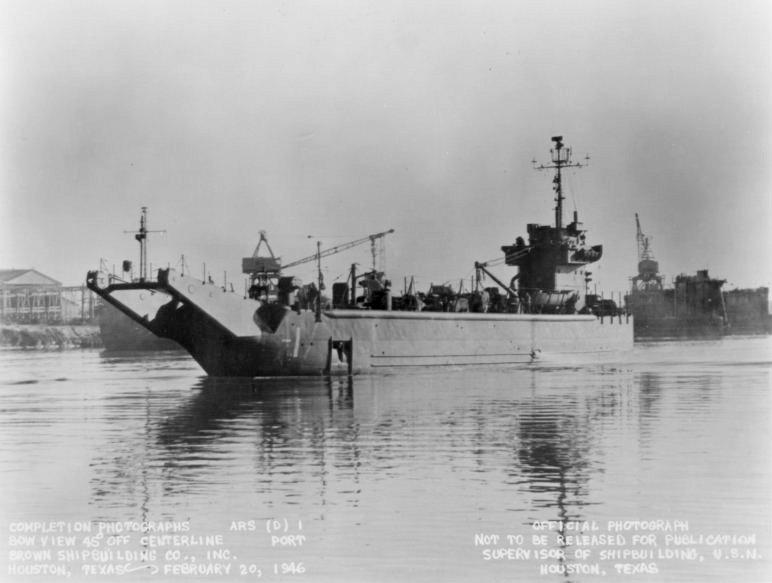
The last four were finally converted as ARS(D), salvage lifting vessels. Here, uss Gypsy, ARS(D)-1
Specs (LSM(R)188:
Displacement: 968 tons – 1,008 tons FL
Dimensions: Same as LSM
Machinery: Same as LSM
Range: Same as LSM
Armament: 5″/38, 2 × 40 mm, 3 × 20 mm AA, 85 Rockets*
Crew: 80
Specs (LSM(R)401:
Displacement: 968 tons – 1,1175 tons FL
Armament: 1-5in/38, 2x 40 mm AA, 4x 20 mm AA, 4 Mortars, 10 RL
Crew: 144
Specs (LSM(R)501:
Displacement: 968 tons – 1,180 tons FL
Armament: 1-5in/38, 4x 40 mm AA, 8x 20 mm AA, 4 Mortars, 20 RL
Crew: same
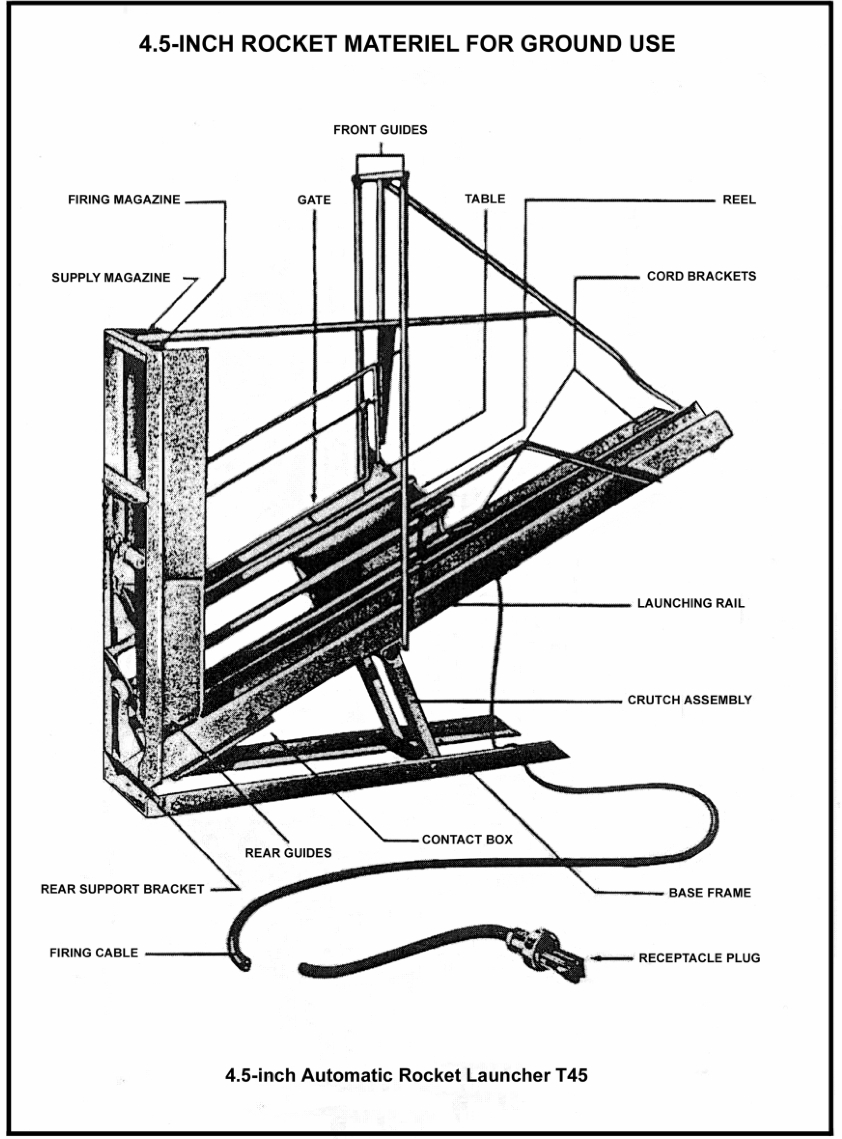
Standard 4.5 in T45 rocker launcher use don support ships and crafts
LCS(L)(3) class fire support craft (1944)
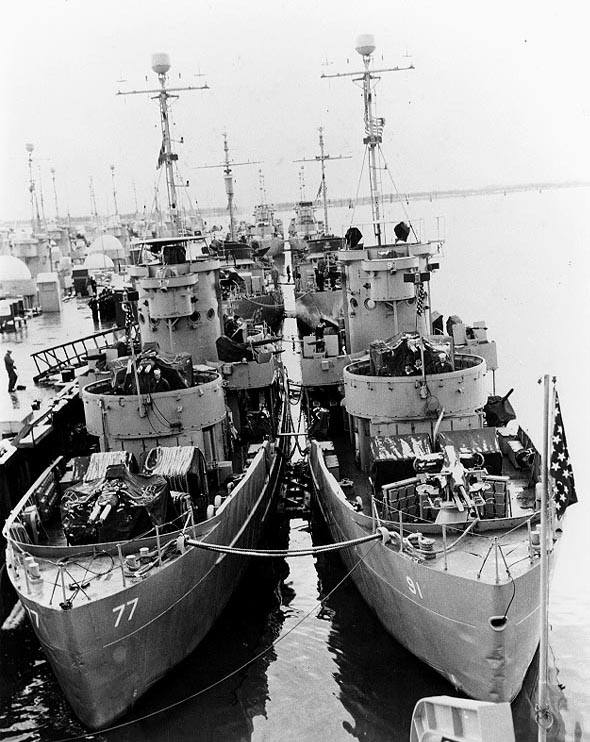
LCS(L)(3)1-LCS(L)(3)130: 130 vessels 1944-1946
In 1943 with the first heavily opposed landings (like at Tarawa) it appeared that both some armor was required on the landing vessels, leading to the LCVP, and heavy support close to the beach was necessary. The first improvized support vessels were LCP(L) converted with their loading bay armed with whatever was available, heavy machine guns or 40 mm guns, mortars or howitzers. This gave birth to the LCS(S) similar to British conversion, of which a few were made (see below). Soon, rockets seemed the best solution. A fully dedicated support vessel called Landing Craft, Support was designed, the L meaning not light but large. The “Landing Craft Support (Large) Mark 3” in the ordnance was later redesignated “Landing Ship Support, Large” (LSSL) from 1949.
Design of the LCS(L)
To accelerate design and construction, it reused the Landing Craft Infantry (LCI). The hull therefore displaced 250 long tons for 158 ft 6 in (48.31 m) long, 23 ft 3 in (7.09 m) wide with a 5 ft 10 in (1.78 m) draft fully loaded. It had had a flat bottom and skegs on either side for beaching withiout damaging the propellers.
The anchor was at the stern, coupled with a winch it was used to pull up the ship off the beach. In addition propellers had twin variable pitch. Each shaft was driven by a bank of four Grey Marine (later GM) diesels, same as the landing craft to eas maintenance and training. In total this provided 1,600 horsepower (1,200 kW) and a top speed of 16.5 knots (30.6 km/h), governed to 12 knots (22 km/h) in usual cruise. Range was a comforable 5,500 nautical miles (10,200 km). Since it was likely to be targeted during the close support, the gun mounts, pilot house and conning tower were all plate over by 10 lb (4.5 kg) STS splinter shields. A smoke generator could be used during the approach. Armament comprised a main dual purpose standard 2-inches forward, two twin 40 mm for and aft and four single 20 mm along the hull, plus the rocket launchers
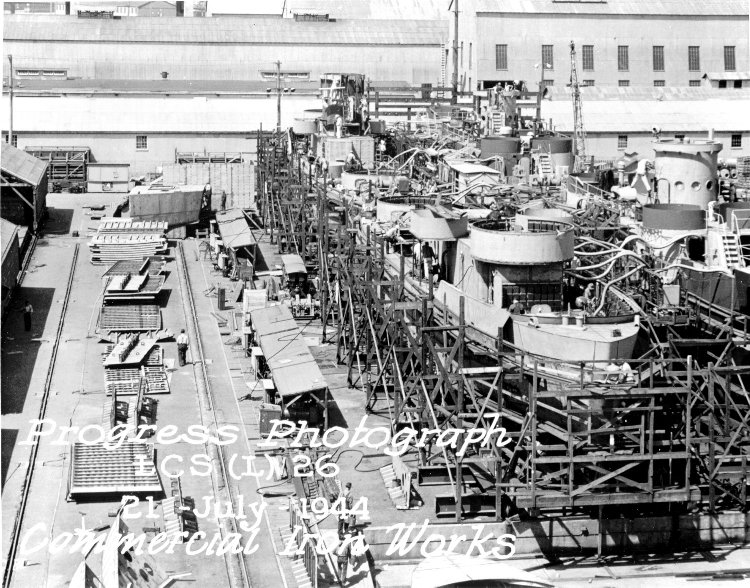
Construction of LCS(L)-26 at Iron Works yard in 1944
Production and service
Only a total of 130 were made, from three selected shipyards: George Lawley & Son (Massachusetts), Commercial Iron Works and Albina Engine Works (Oregon). With many simplifications in design and extreme modularity and standardization, the yards were able to produce one every 10 days in some cases, with fitting out taking a few weeks. They also proved able fire fighting ships, using their onboard fighting manifold at the front of the bow gun and pumps. Despite the way they were built these vessels were resilient and had an exceptionally long career spanning the cold war, until 1997 for some.
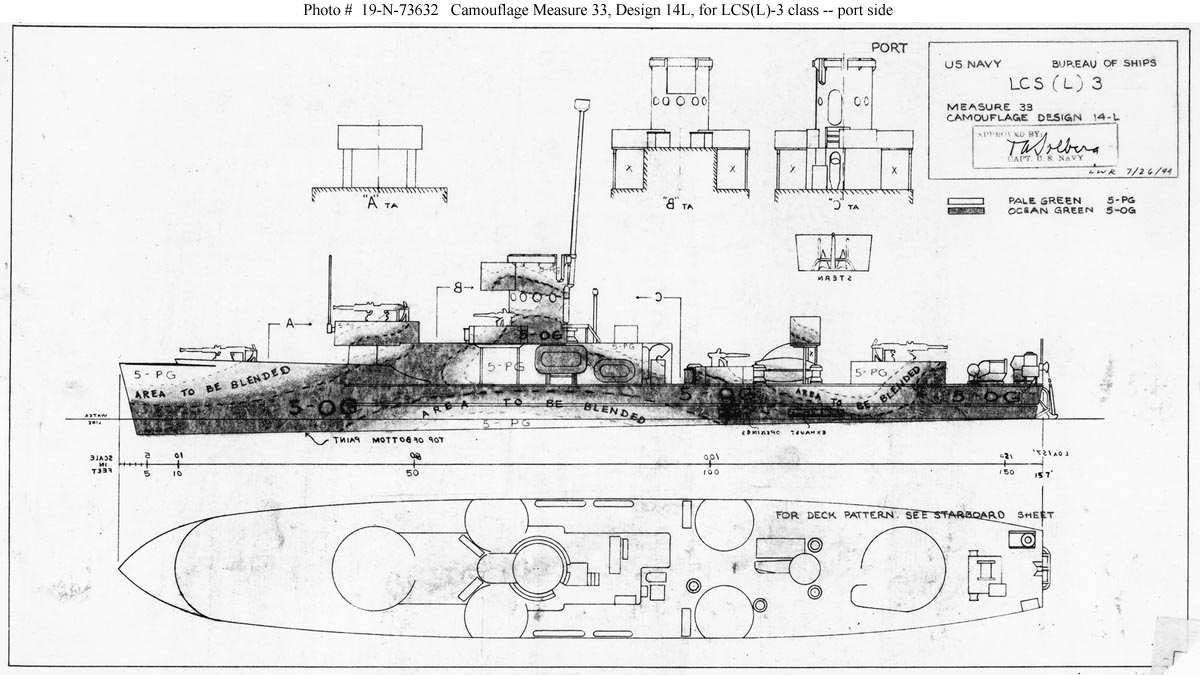
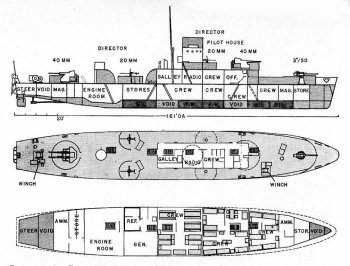
Schematics and camouflage pattern, ONI.
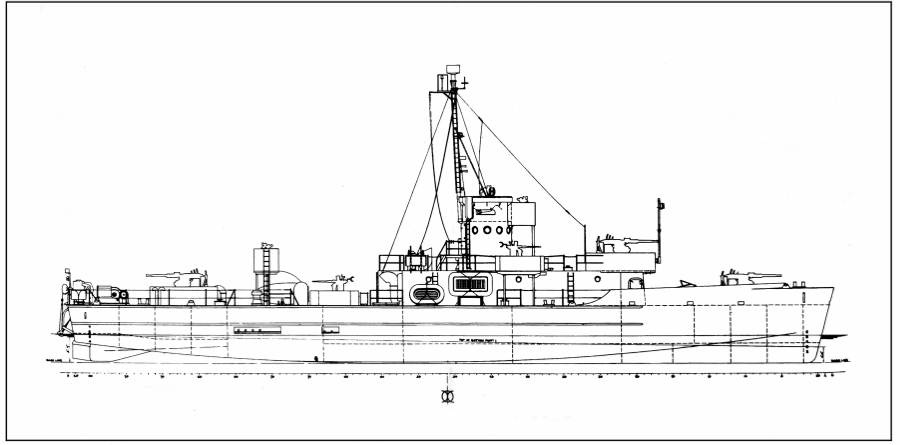
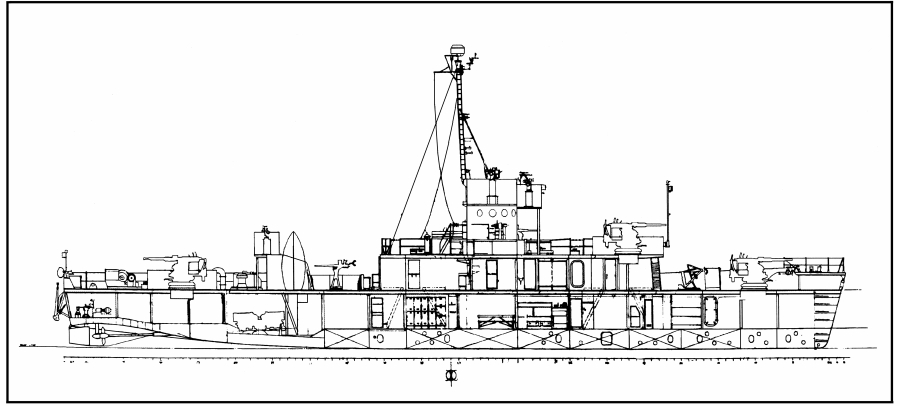
LCS(L)(3) Inboard Profile from Plan No. 1711-111-23 by George Lawley & Son Corporation (src erenow.ne).
Specs (LCS(L)(3):
Displacement: 250 tons – 387 tons FL
Dimensions: 48.16 x 7.21 x 1.7 m (158 x 24 x 5 ft 7 in)
Machinery: 2 shaft diesels, 2320 bhp, 16.5 kts
Range: Oil 76 tons, 5,500 nm
Armament: 1x 5″/38, 4× 40 mm, 4× 20 mm AA, 10 Rockets launchers
Crew: 71
LCS(S) class fire support craft (1943)
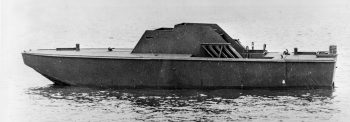
558 built (LCS(S)(1) and (2) combined with identification numbers 1943-44
The LCS(S) was the “little brother” of the LCS(L), “S” standing for “small”. It was carried on the davits of any assault ship, making it handy for coordinating an attack. Early landings of small islands comprised rarely more than six APA (assault ships), so to allow having at least six of these support LCS(S) nearby, all armed with rocket launchers and smoke pots to cover the approach.
Two variants were converted:
–LCS(S)(1) or Mark 1, ame with two 0.5 cal. heavy machine guns or three .3 cal. M1919A4 light MGs or one 0.5 and two 0.3. They were essentially gunboats, firing from the beach, possibly with a mortar inside if there was enough room for it. It had a petrol engine, relatively fast at 12 knots for 250 bhp and a range of 115 nm at that speed.
-LCS(S)(2) Mark 2 was given one 0.5, two 0.3 in MGs and two 12-inches (305 mm) rocket launchers. It was propelled by a 225 bhp diesel for 11.5 knots and had a greater range of 135 nm.
Both had light STS armour plates to protect the crew of 6.
Amphibious commander likes them but wanter more powerful armament, notably 20 mm Oerlikon, which was difficult because of its weight and stability. Nevertheless they took part in virtually all amphibious operations in late 1943 and until Okinawa. They worked well combined with the larger LCS(L).
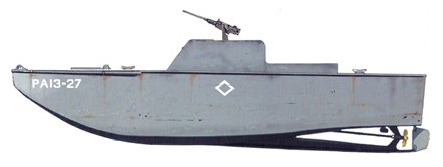
Profile of a LCS(S)(2)
Specs LCS(S)(2):
Displacement: 250 tons – 387 tons FL
Dimensions: 48.16 x 7.21 x 1.7 m (158 x 24 x 5 ft 7 in)
Machinery: 2 shaft diesels, 2320 bhp, 16.5 kts
Range: Oil 76 tons, 5,500 nm
Armament: 1x 5″/38, 4× 40 mm, 4× 20 mm AA, 10 Rockets launchers
Crew: 71
In October 1943, the doctrine started to change, to privilegy a combination of sea-going support ships and onboard support crafts. The sea going support was likely to be as gunboat (LSG/LCG). In complement to a massive amphibious craft fleet, troops also were carried to shore using amphibious vehicles, wheeled, either softskin or armoured, and all armed. They were used and developed separately for the US Army and USMC, sometimes used by both. The European theater saw the used mostly of unarmoured vehicle, and the DUKW in that guise, overshadowed all the others. Others were more common in the pacific, like the Weasel, while the latter theater of operation saw a large use of tracked vehicles, which on small islands came in handy as Japanese armour was scarce. The bulk were reserved in China, or spread in penny packets in the largest islands. The Philippines, Iwo Jima, Tarawa, and Okinawa in particular, had tanks units to engage. The tank battles at Okinawa was the last and largest in the pacific. However, this was the exception. In many other smaller, less strategic island, there was little or no armoured support at all. In those cases, LVTs were perfectly fit to assume this armoured support to the USMC. The acronym, meaning “Landing Vehicle, Tracked”, was a way to carry troops to the beach and in the inland as well, but moreover to circumvent the problem of atolls, which often presented a natural obstacle to conventional landing crafts: Coral. In general in all these small pacific volcanic islands and islets, they surrounded lagoons, for which there were little accesses. LVTs just climbed these coral reefs and went over up to the beaches. So they really made a difference. The serie started with the Alligator built in Louisiana, known for its large marshy area, like Florida, and the serie went on up to the LVT-4. In addition to two powerful diesels housed in the sides to free the central compartment for troops and in some case light vehicles like a jeep, they had an enclosed, armoured compartment for the driver and co-driver, and machine guns aplenty. In some case, conversions were made for close support with a variety of tank turrets. For propulsion in water they did not had propeller screws, that could have been damaged in the reefs, but rather simply grousers on the track links, paddling water backward. In all, from July 1941 to September 1945, 18,616 LVTs of all variants were delivered to the USMC and US Army as well as the allies via lend-lease. The concept was refined during the cold war, introducing new fully enclosed vehicles such as the LVTP-5 and the LVTP-7 in the late 1970s. //www.navsource.org/archives/phibidx.htm The US Navy ONI 226 Booklet is a 132-page document delailing all the allied landing crafts, with technical sheets, drawings and schemes. It is our primary source on the subject matter. Conway’s all the world’s fighting ships Models of the LST (Scalemates)
To conclude on supprot ships and crafts, the Bureau of Ships (BuShips) studied other alternatived such as a modified version of the LCC control craft (never built, so never converted), the PCS 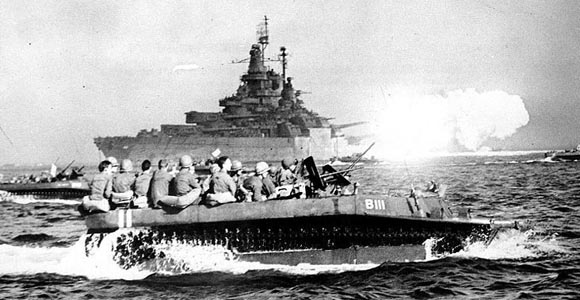
LVTs at Okinawa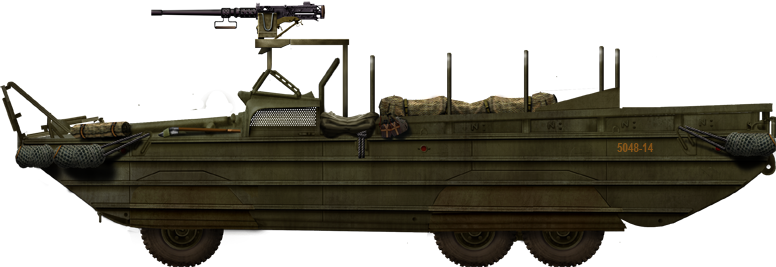
DUKW. Produced by GMC this was the standard amphibious truck of the allies in WW2. Based on a standard GMC-353 truck, and with 21,147 built it served on all fronts, all operations, from the pacific to russia, fording rivers and lakes as well. They were operated by the LSTs, LSVs, and LSDs in particular.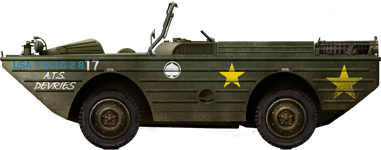
Ford GPA: In complete contrast to the success of the GMC DUKW, the “Seep” was a failure. Not so obvious as to cancel it as the US Govt. accepted to purchase 12,778 of these, based on Ford’s masterful maketing which sold it as the “amphibious jeep”. Alas, when reports made its defaults apparent, production was curtailed in 1943, after less than a year.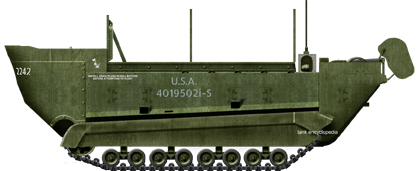
M29 Weasel: Another US Army sofskin vehicle used in amphibious operations (but mostly marshy areas, rivers and lakes), the M29 Weasel was produced by Studebaker from 1942 to 1945 to 15,892 vehicles. It was a tracked utility vehicle called a “cargo carrier”, air-transportable, go-anywhere, and partly amphibious. Designed by British Inventor Geoffrey Pyke, it had large tracks to go easily on sand, snow and muck. The M29C Water Weasel was its main variant, fully amphibious. It was even given additional pontoons fore and aft for seaworthiness as well as water pumps and rudders. It was used in Italy, the Western Front, and the Pacific. It also helped crossing the Rhine in 1945. The concept was sound enough more were produced after WW2, and it soldiered in Korea and Vietnam as well.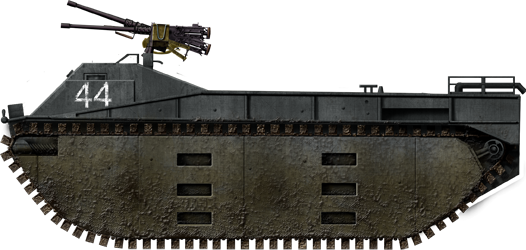
The LVT-1 Alligator was the first vehicle of its kind. It was the First model adopted by the USMC, caracterised by its engine at the back, forcing Marines to jump overboard by the sides. Despite this, 7,225 were manufactured, seeing action in virtually all pacific landings.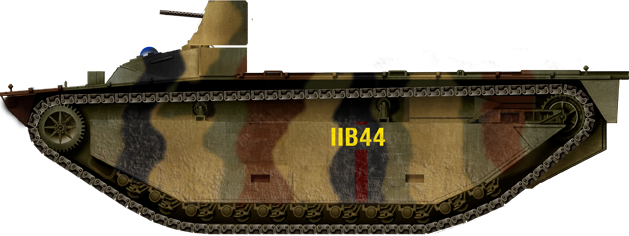
The LVT-2 “Water Buffalo” was basically an all-out improvement over the LVT-1 with better mobility, carrying 24 Marines. It was declined into the armoured LVT(A)2 as well. 2962 were delivered until late 1943 by the Food & Machinery Corp (FMC) in addition to 2,450 armoured LVT(A)2. They saw action in Tarawa, Roi-Namur, Cape Gloucester, Northern Kwajalein, Saipan, Guam, Tinian, Peleliu, Iwo Jima and Okinawa.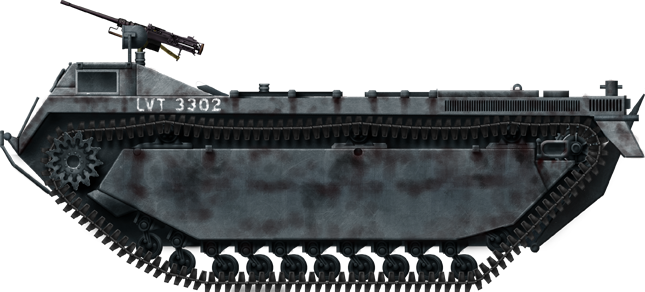
The LVT-3 Bushmaster was a brand new concept, designed by the Borg Warner Corporation. It had a ramp aft to dismeblarked troops like in modern APCs. Because it no longer exposed Marines to enemy fire, the model was largely adopted with 2964 built, about the same number as LVT-2s. It was used in Iwo jima, okinawa and was still in use in Korea, taking an important part in the landing at Inchon, in September 1950.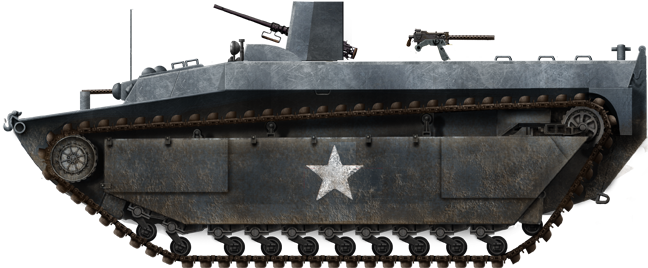
The LVT-4 Water Buffalo was the last great wartime type of LVT, basically an improvement over the LVT-2 with a stern ramp for unloading of personnel. It was produced from 1943, with 8,348 vehicles, the largest serie. It saw an extensive use with the British and commonwealth troops as well and made a nice career during the cold war as well, declined into many versions.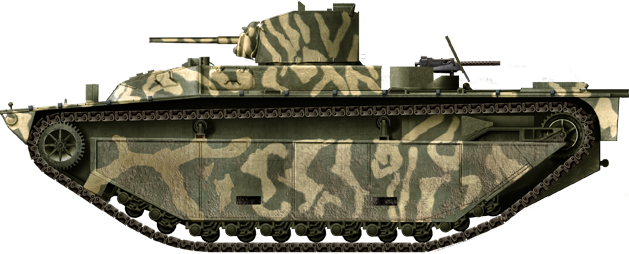
The LVT(A)1 was basically an armoured support version of the Alligator. It was fitted with a standard M3 Stuart turret and introduced by FMC in late 1942. It saw action in number for the first time At Roi-Namur, with the 24th Marines. Other supported the 22nd Marines at Engebi. By mid-1944, they were gradually replaced by the LVT(A)-4. 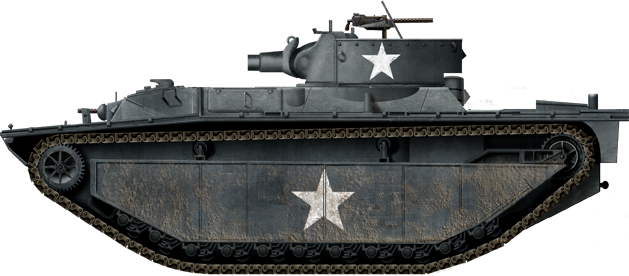
The LVT(A)-2 Amtrack II was a support version derivative of FMC’s LVT-2. It was produced from 1943, after lessons were learned in the South Pacific, asking for more protection. it could carry 18 troops and only 450 units were produced. 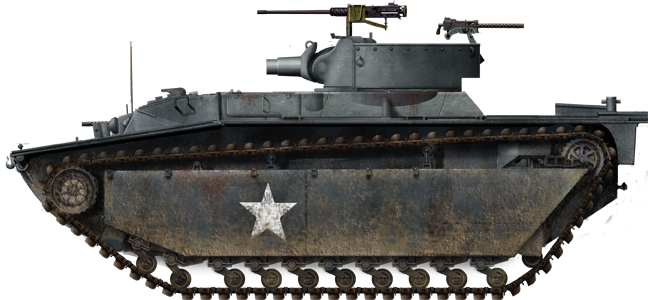
The LVT(A)4 was the last support variant of WW2. It was introduced in 1944, making an enormous contribution as it accepted the 75 mm Howitzer Motor Carriage M8 turret, or in some cases, the Canadian Ronson flamethrower. 1,890 units were produced, including 1,307 transferred to US Army and British Army. They saw heavy action in Iwo Jima and Okinawa but in the Korean war as well.Resources/Read More
Links/Src
//www.mightymidgets.org/
//www.ibiblio.org/hyperwar/USN/ships/ships-lc.html#lcsl
//vdocuments.mx/oni-226-allied-landing-craft-1943.html
//www.naval-encyclopedia.com/ww2/uk/british-amphibious-ships-and-landing-crafts/
//pwencycl.kgbudge.com/L/c/LCPR_class.htm
//www.ibiblio.org/hyperwar/USMC/ref/Amphibious/Amphibious-3.html#page17
ONI 225 Landing Crafts (PDF)
//www.ibiblio.org/hyperwar/USN/ships/ships-lcpr.html
//www.pwencycl.kgbudge.com/L/c/LCS_class.htm
https://www.navypedia.org/ships/usa/us_aws_lcv_lcsl3.htm
WWII Construction LCS(L) archive
French Dynassault and other ex-US amphibious vessels in Indochina
Combined operations crafts – ONI booklet schemes and drawings USHNM
Article on Higgins boats in popular mech 1935
List of APA ships on history.navy.mil
//erenow.net/ww/american-amphibious-gunboats-wwii-history-lci-lcsl-ships-pacific/2.php
//en.wikipedia.org/wiki/Category:World_War_II_amphibious_warfare_vessels_of_the_United_States
//en.wikipedia.org/wiki/Haskell-class_attack_transport
//en.wikipedia.org/wiki/Doyen-class_attack_transport
//en.wikipedia.org/wiki/Gilliam-class_attack_transport
//en.wikipedia.org/wiki/Frederick_Funston-class_attack_transport
//en.wikipedia.org/wiki/Sumter-class_attack_transport
//en.wikipedia.org/wiki/Ormsby-class_attack_transport
//en.wikipedia.org/wiki/Arthur_Middleton-class_attack_transport
//en.wikipedia.org/wiki/Bayfield-class_attack_transport
//en.wikipedia.org/wiki/Frederick_Funston-class_attack_transport
//en.wikipedia.org/wiki/Windsor-class_attack_transport
//en.wikipedia.org/wiki/USS_John_Penn_(APA-23)
//en.wikipedia.org/wiki/Heywood-class_attack_transport
//en.wikipedia.org/wiki/Harris-class_attack_transport
//www.navsource.org/archives/10/14/14001.htm
//drawings.usmaritimecommission.de/drawingmain.htm
//drawings.usmaritimecommission.de/drawings_c3.htm
//www.michaelmcfadyenscuba.info/viewpage.php?page_id=378
//www.navsource.org/archives/10/03/03023.htm
//www.history.navy.mil/research/histories/ship-histories/danfs.html
//www.navalhistory.org/2018/03/01/rocket-ships-a-pictorial-overview
//www.dobrinkman.net/lowndes/ship.htm
//www.hazegray.org/danfs/amphib/
//www.kirkusreviews.com/book-reviews/a/kenneth-dodson-2/away-all-boats-2/
//www.usslcs102.org/Document: ONI 226 booklet
Books
U.S. Amphibious Ships and Craft: An Illustrated Design History Hardcover – November 1, 2002
Friedman, Norman (2002). U.S. Amphibious Ships and Craft. Naval Institute Press. p. 190.
American Amphibious Gunboats in World War II: A History of LCI and LCS(L) Ships in the Pacific, by Robin L. Rielly
Landing Ship, Tank (LST) 1942–2002 (New Vanguard Book 115)
Landing Craft, Infantry and Fire Support (New Vanguard Book 157) Gordon L. Rottman, Peter BullVideos
Away all boats (1956) – Full movie
History Channel: Hero Ships – Landing Ship Tanks
About the DUKW
Navy Movie amphibious warfare
Navy Movie LSTsModel Kits corner
Bayfield class Airfix 1/400
Review of the kit on steelnavy.com
Artemis class APA Loose cannone 1:700
USS Callaway APA-35, WSW Modellbau | No. 700-24-03 | 1:700
LCVP and LCVP
Many brands, mostly 1/72 but also 1:32, 35 and 48.
LCT models, mostly 1/125 to 1.400

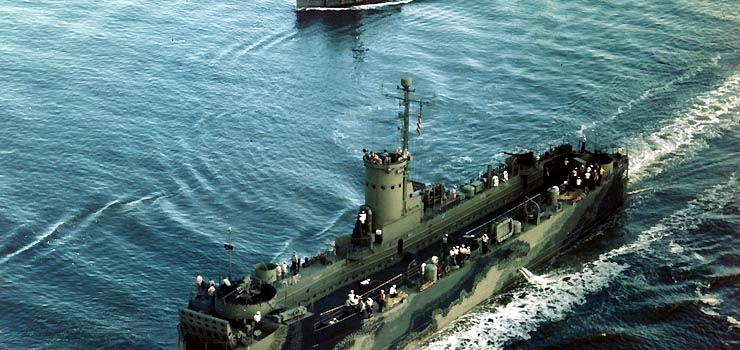

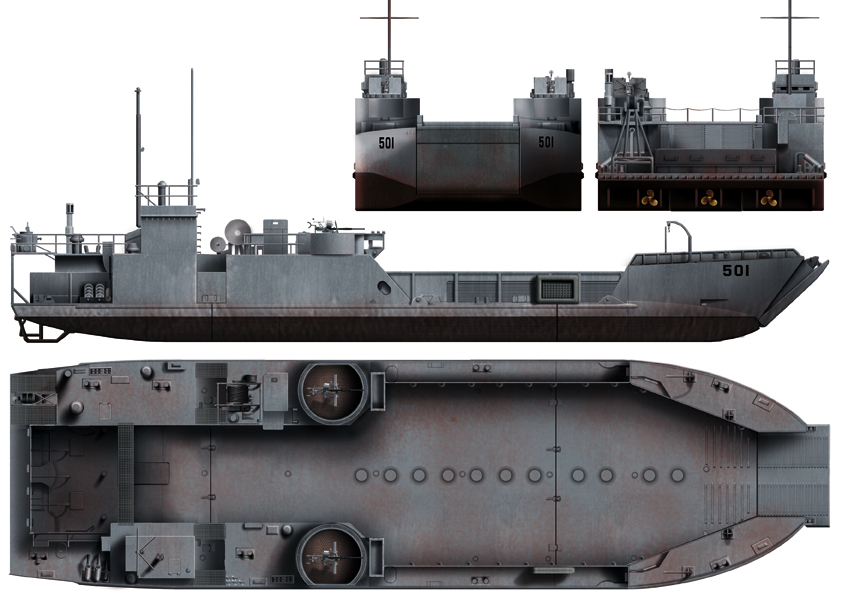
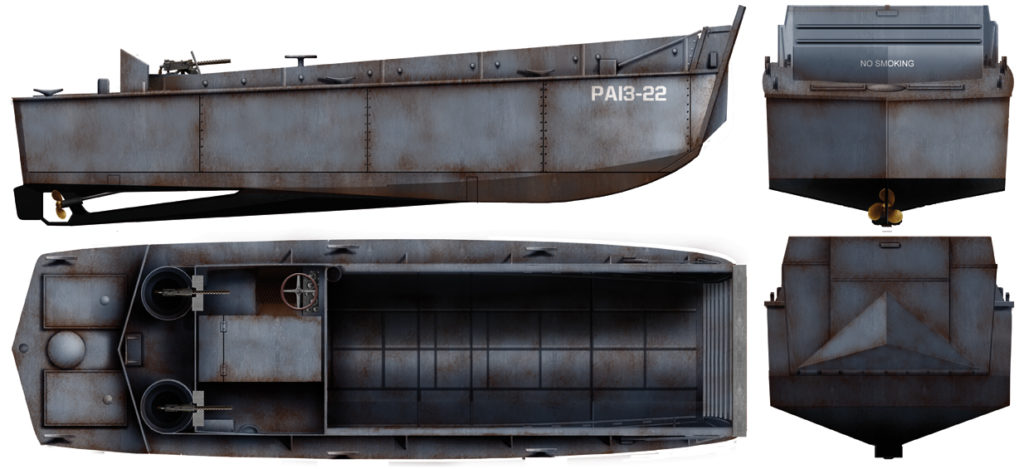
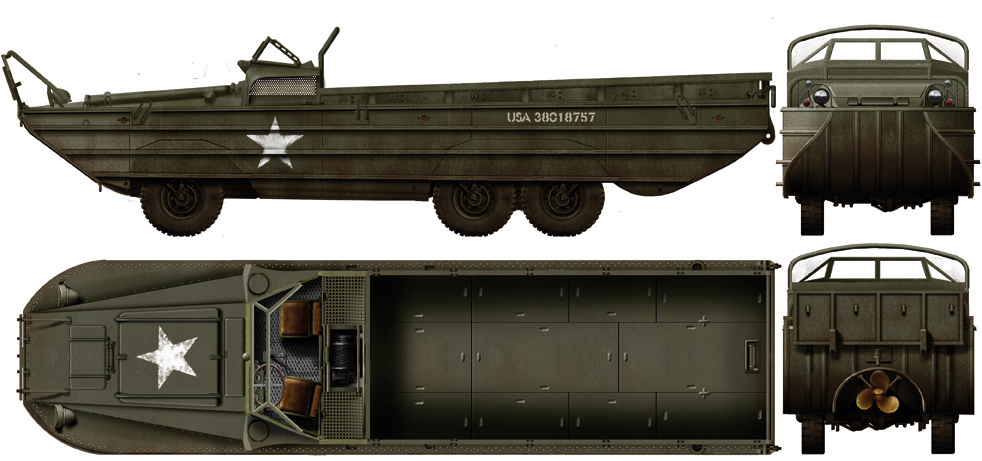
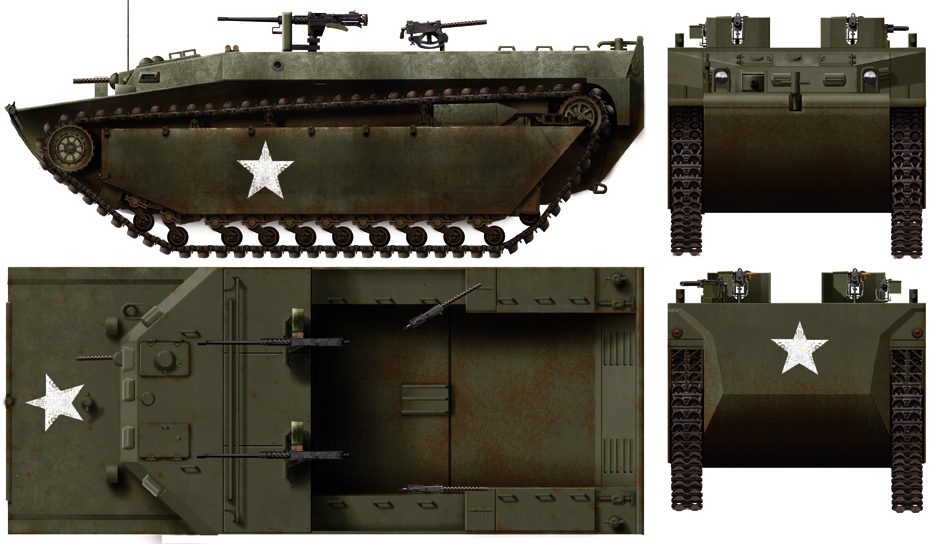
 Latest Facebook Entry -
Latest Facebook Entry -  X(Tweeter) Naval Encyclopedia's deck archive
X(Tweeter) Naval Encyclopedia's deck archive Instagram (@navalencyc)
Instagram (@navalencyc)





 French Navy
French Navy Royal Navy
Royal Navy Russian Navy
Russian Navy Armada Espanola
Armada Espanola Austrian Navy
Austrian Navy K.u.K. Kriegsmarine
K.u.K. Kriegsmarine Dansk Marine
Dansk Marine Nautiko Hellenon
Nautiko Hellenon Koninklije Marine 1870
Koninklije Marine 1870 Marinha do Brasil
Marinha do Brasil Osmanlı Donanması
Osmanlı Donanması Marina Do Peru
Marina Do Peru Marinha do Portugal
Marinha do Portugal Regia Marina 1870
Regia Marina 1870 Nihhon Kaigun 1870
Nihhon Kaigun 1870 Preußische Marine 1870
Preußische Marine 1870 Russkiy Flot 1870
Russkiy Flot 1870 Svenska marinen
Svenska marinen Søværnet
Søværnet Union Navy
Union Navy Confederate Navy
Confederate Navy Armada de Argentina
Armada de Argentina Imperial Chinese Navy
Imperial Chinese Navy Marinha do Portugal
Marinha do Portugal Mexico
Mexico Kaiserliche Marine
Kaiserliche Marine 1898 US Navy
1898 US Navy Sovietskiy Flot
Sovietskiy Flot Royal Canadian Navy
Royal Canadian Navy Royal Australian Navy
Royal Australian Navy RNZN Fleet
RNZN Fleet Chinese Navy 1937
Chinese Navy 1937 Kriegsmarine
Kriegsmarine Chilean Navy
Chilean Navy Danish Navy
Danish Navy Finnish Navy
Finnish Navy Hellenic Navy
Hellenic Navy Polish Navy
Polish Navy Romanian Navy
Romanian Navy Turkish Navy
Turkish Navy Royal Yugoslav Navy
Royal Yugoslav Navy Royal Thai Navy
Royal Thai Navy Minor Navies
Minor Navies Albania
Albania Austria
Austria Belgium
Belgium Columbia
Columbia Costa Rica
Costa Rica Cuba
Cuba Czechoslovakia
Czechoslovakia Dominican Republic
Dominican Republic Haiti
Haiti Hungary
Hungary Honduras
Honduras Estonia
Estonia Iceland
Iceland Eire
Eire Equador
Equador Iran
Iran Iraq
Iraq Latvia
Latvia Liberia
Liberia Lithuania
Lithuania Mandchukuo
Mandchukuo Morocco
Morocco Nicaragua
Nicaragua Persia
Persia San Salvador
San Salvador Sarawak
Sarawak Uruguay
Uruguay Venezuela
Venezuela Zanzibar
Zanzibar Warsaw Pact Navies
Warsaw Pact Navies Bulgaria
Bulgaria Hungary
Hungary

 Bundesmarine
Bundesmarine Dutch Navy
Dutch Navy Hellenic Navy
Hellenic Navy Marina Militare
Marina Militare Yugoslav Navy
Yugoslav Navy Chinese Navy
Chinese Navy Indian Navy
Indian Navy Indonesian Navy
Indonesian Navy JMSDF
JMSDF North Korean Navy
North Korean Navy Pakistani Navy
Pakistani Navy Philippines Navy
Philippines Navy ROKN
ROKN Rep. of Singapore Navy
Rep. of Singapore Navy Taiwanese Navy
Taiwanese Navy IDF Navy
IDF Navy Saudi Navy
Saudi Navy Royal New Zealand Navy
Royal New Zealand Navy Egyptian Navy
Egyptian Navy South African Navy
South African Navy






























 Ukrainian Navy
Ukrainian Navy dbodesign
dbodesign